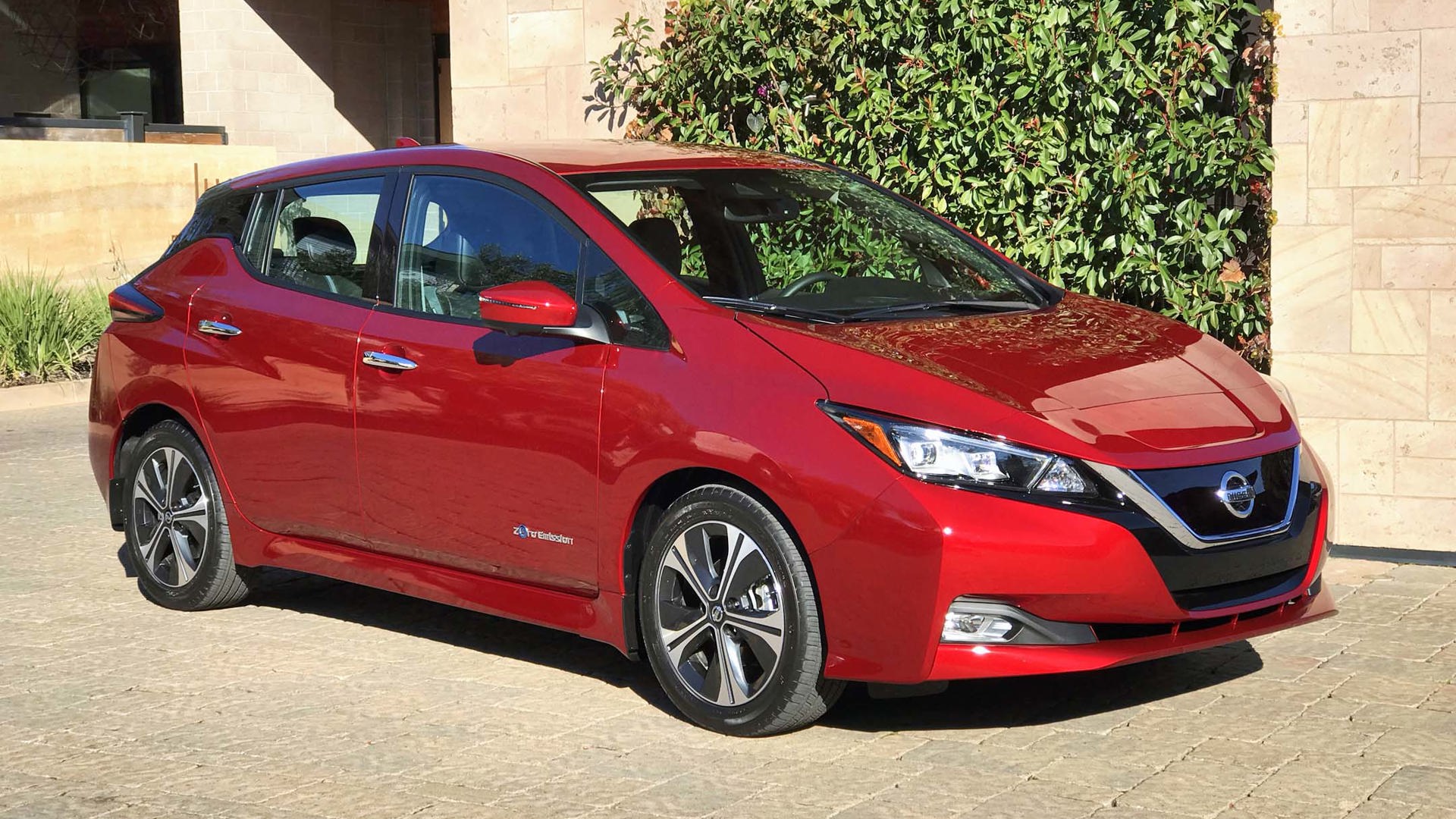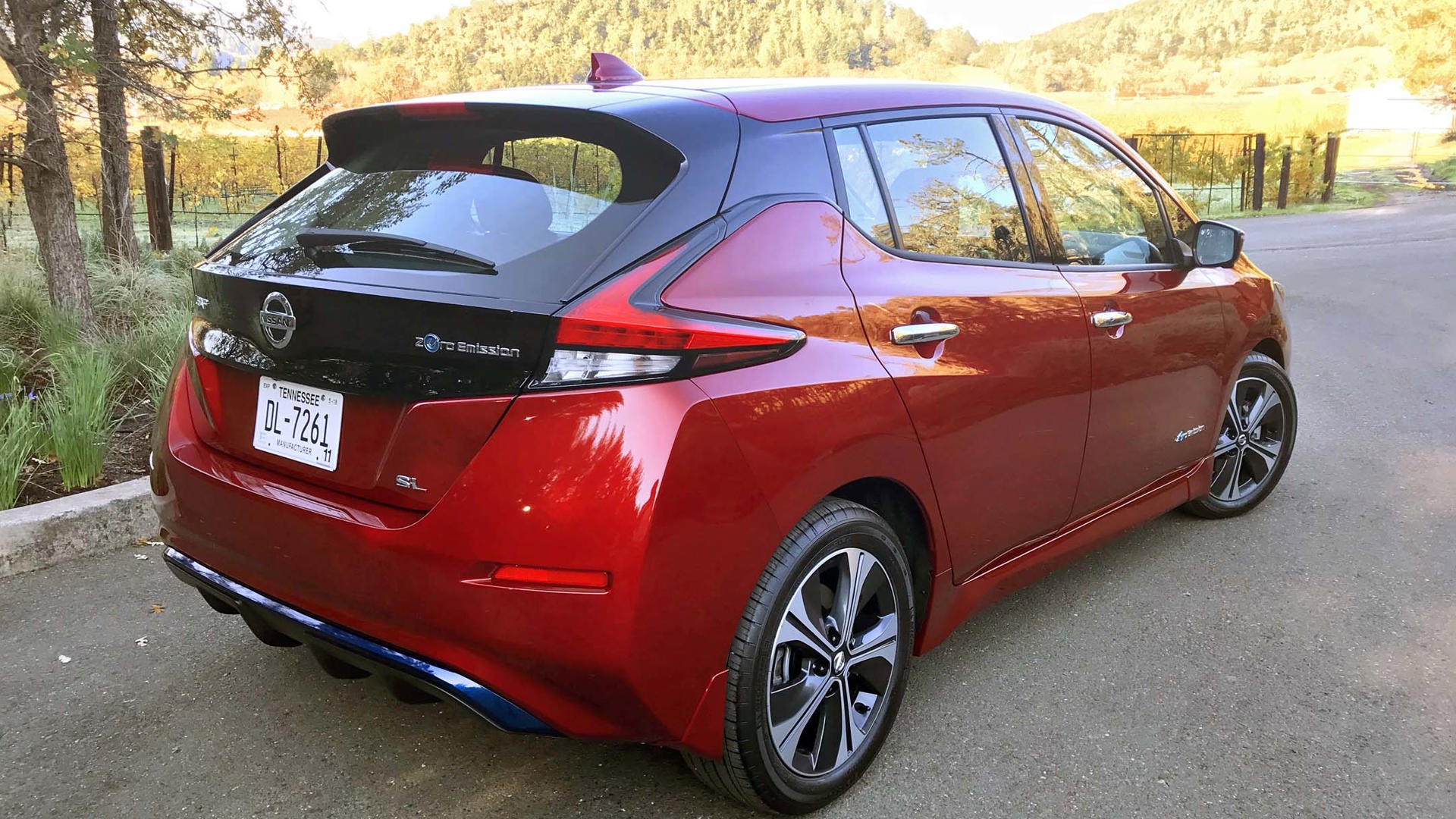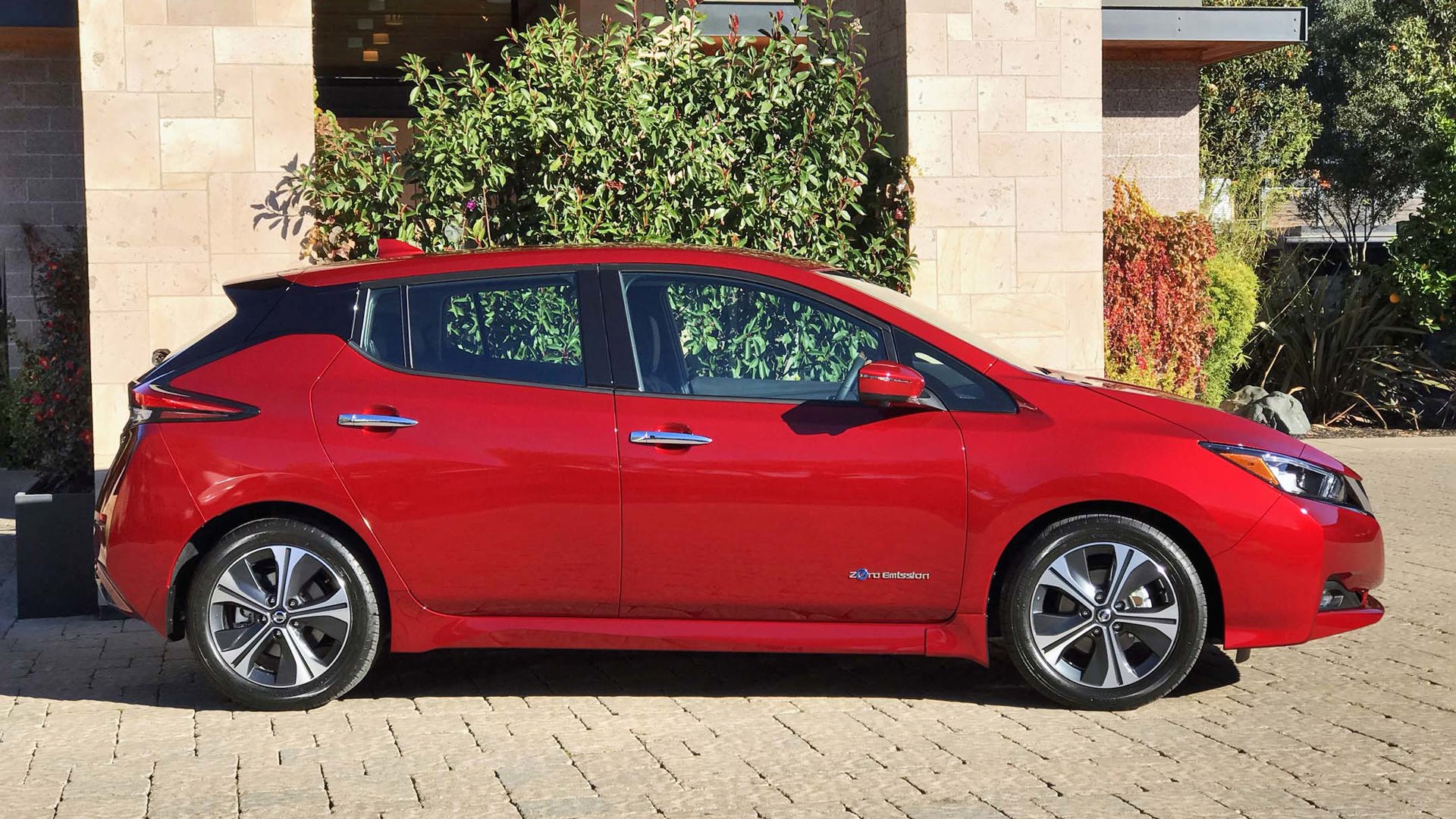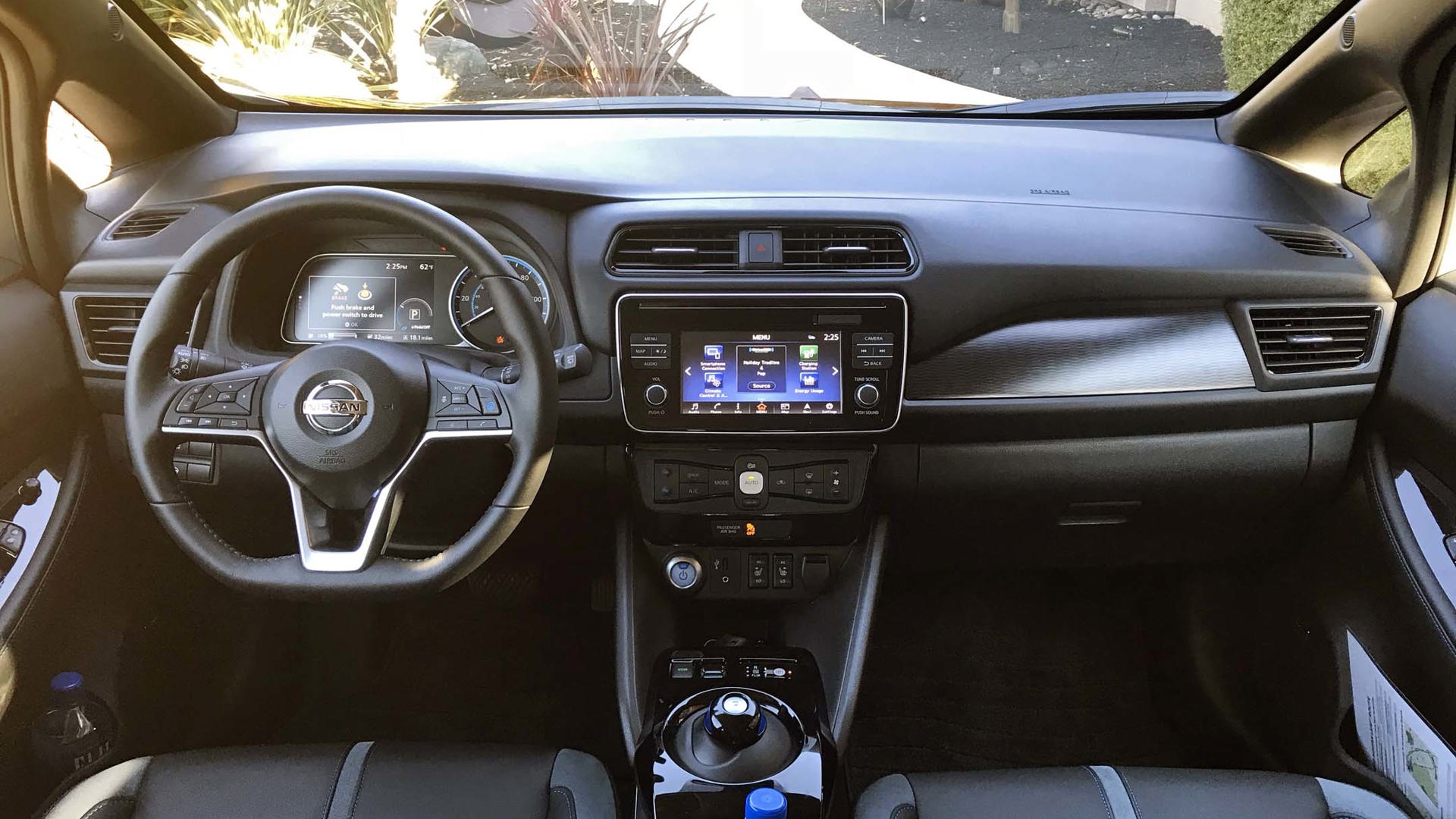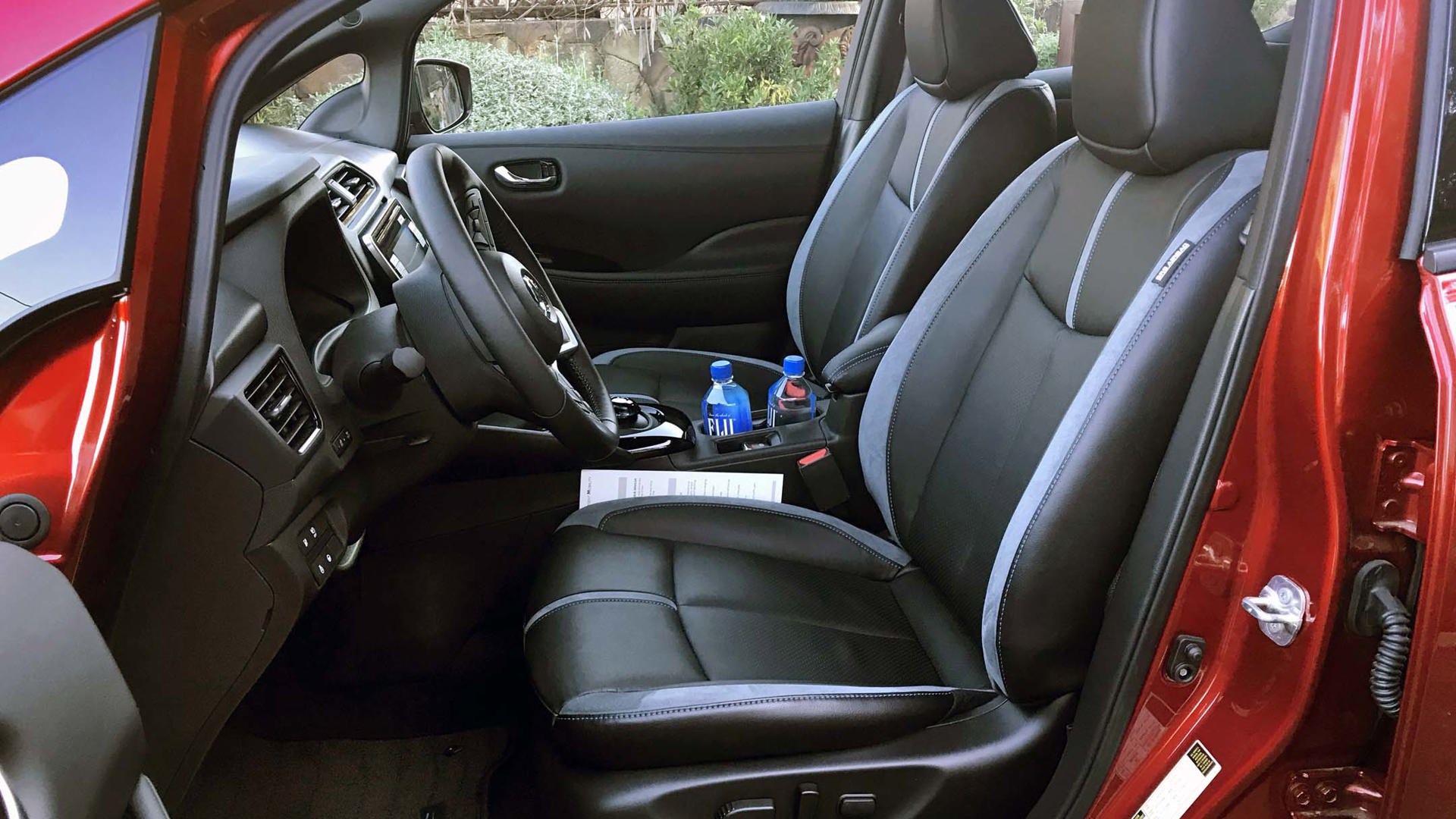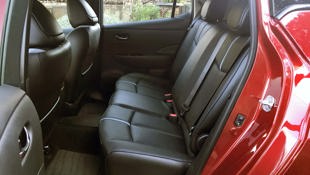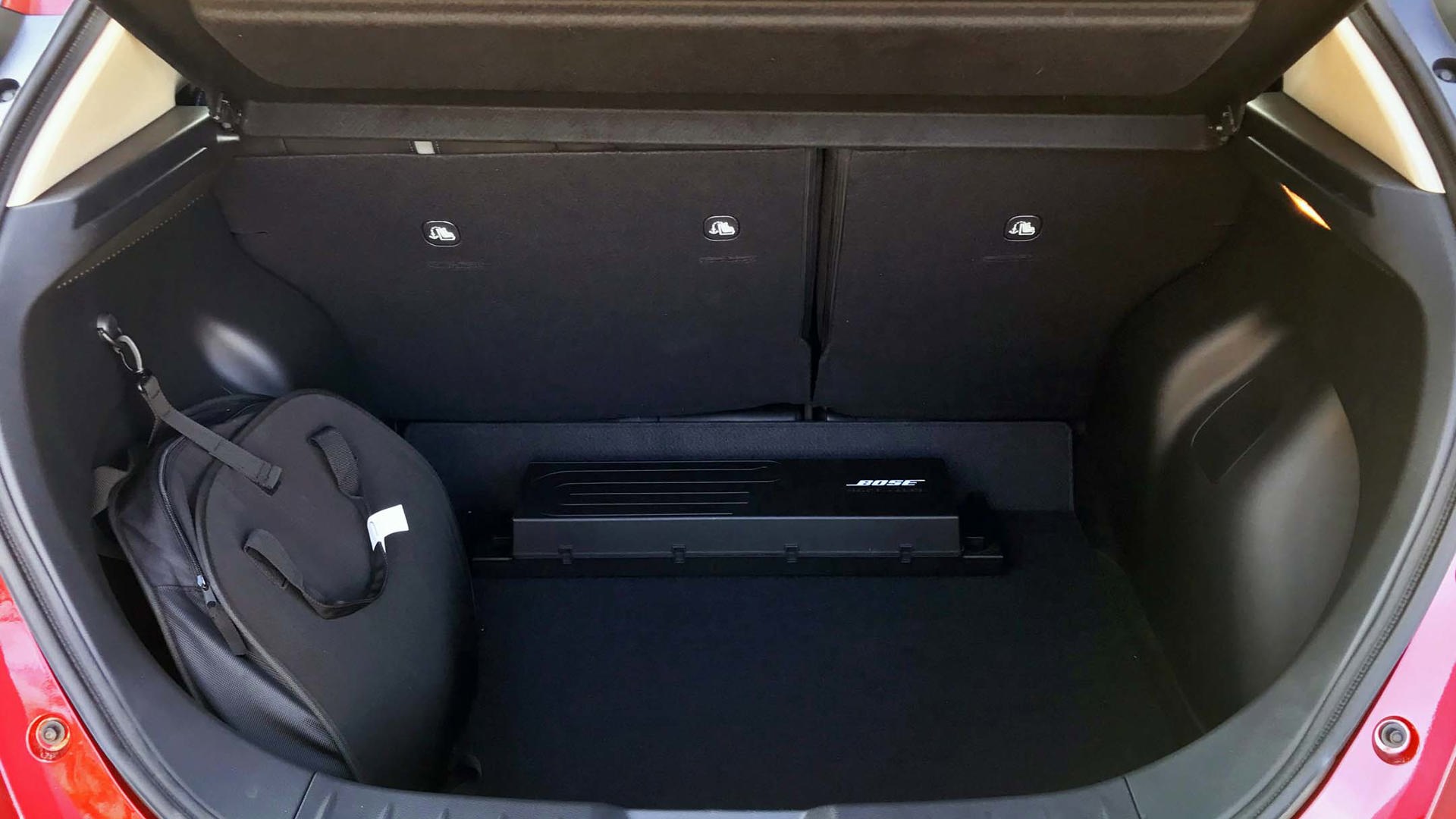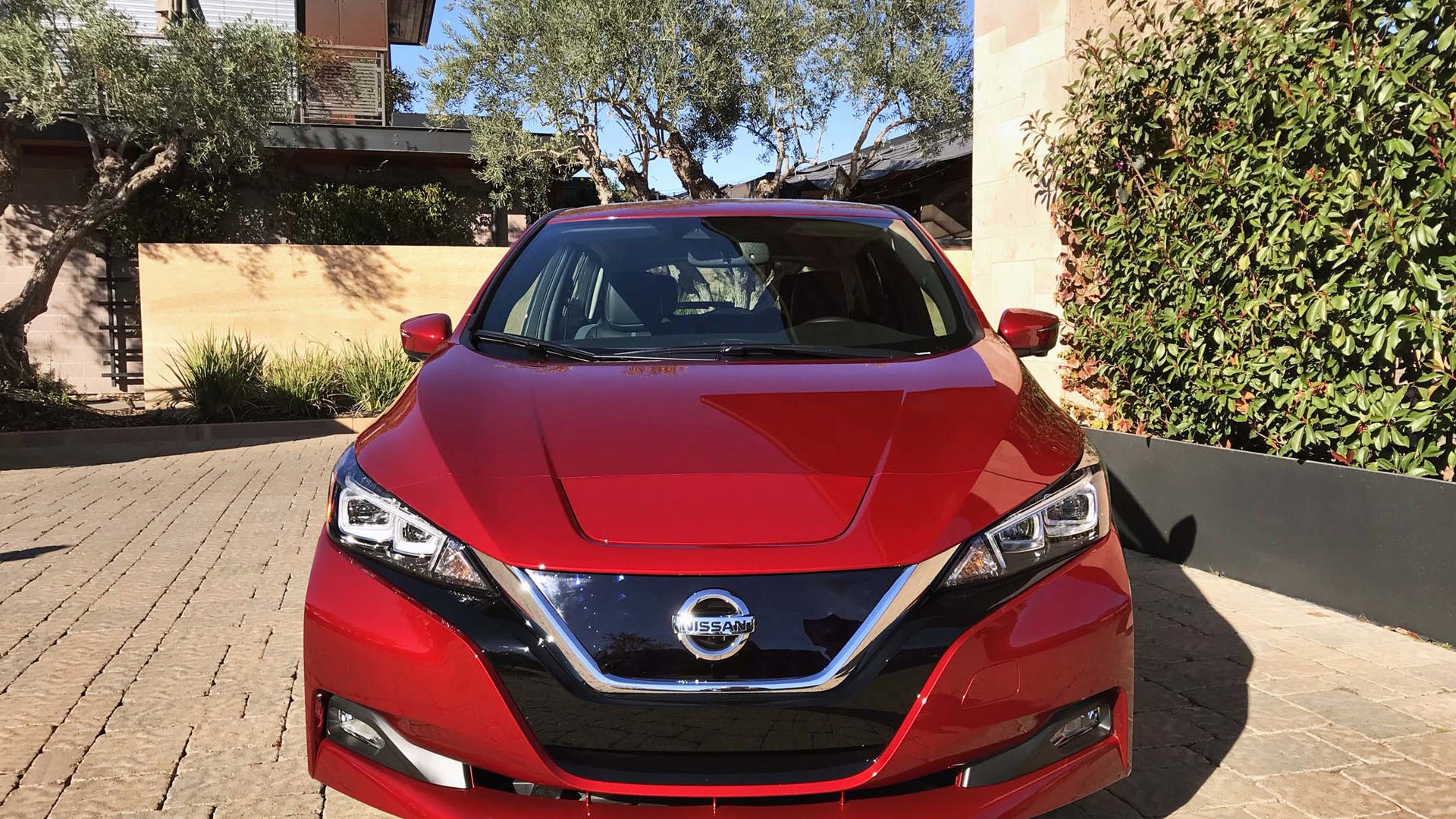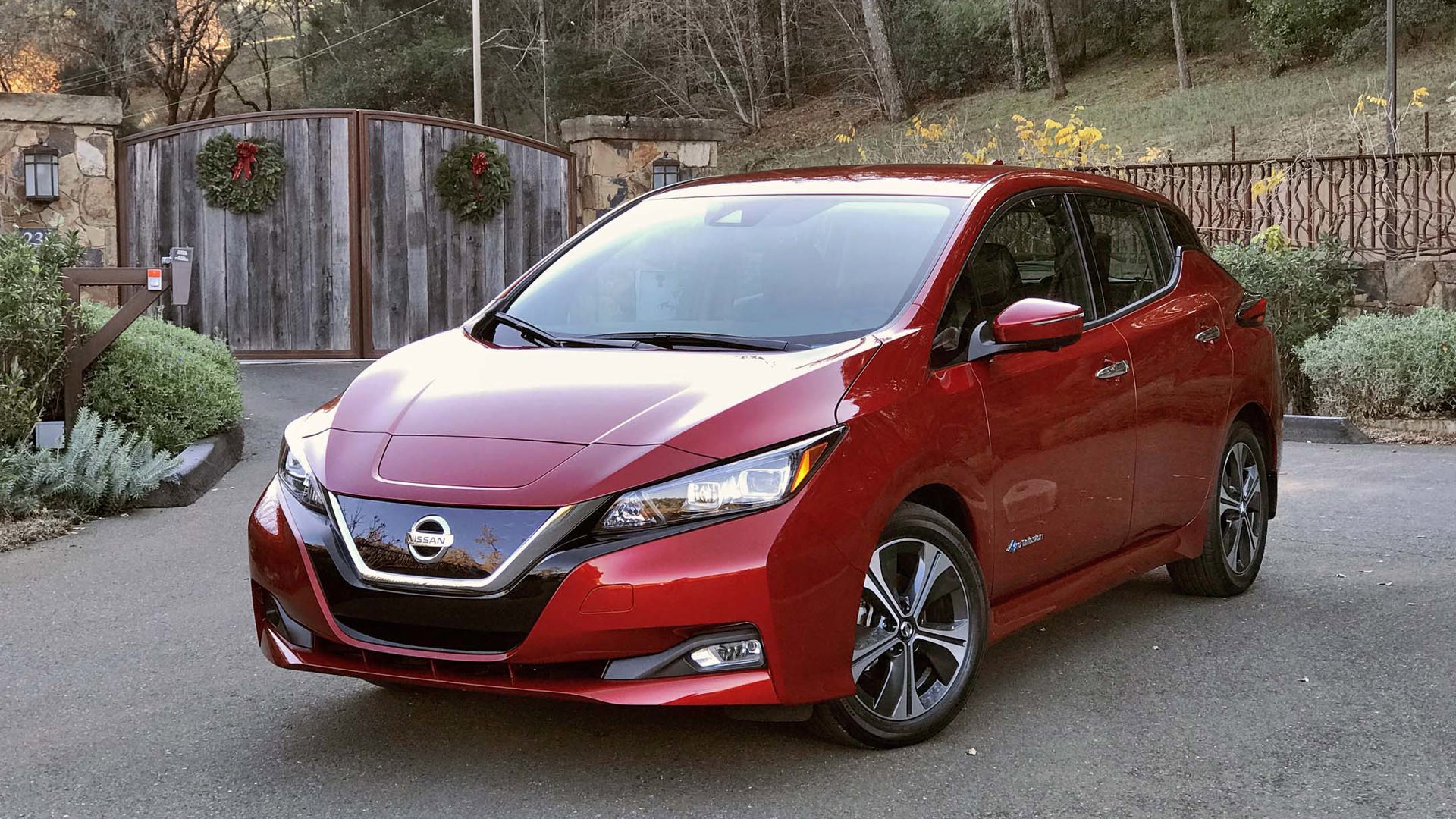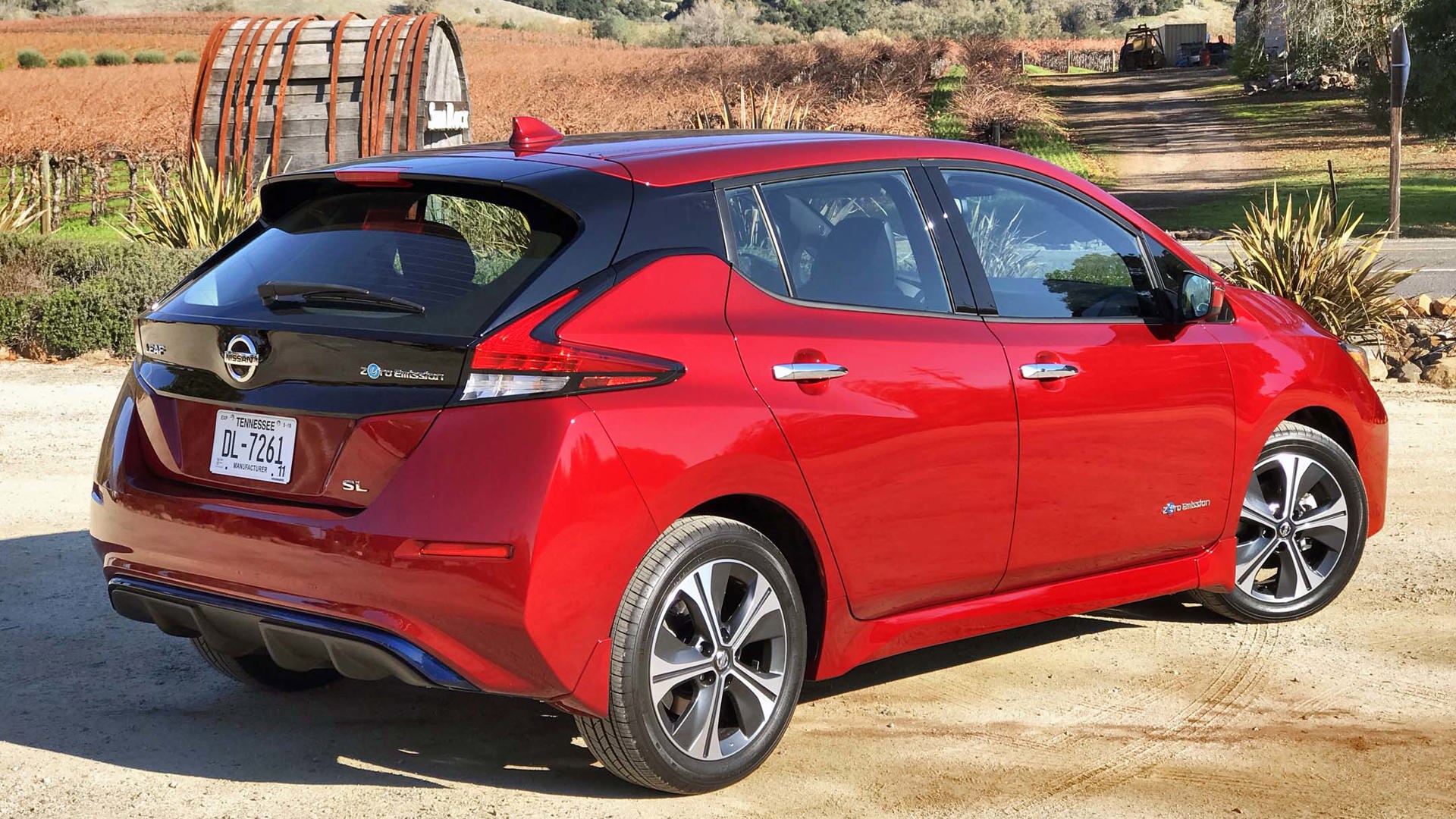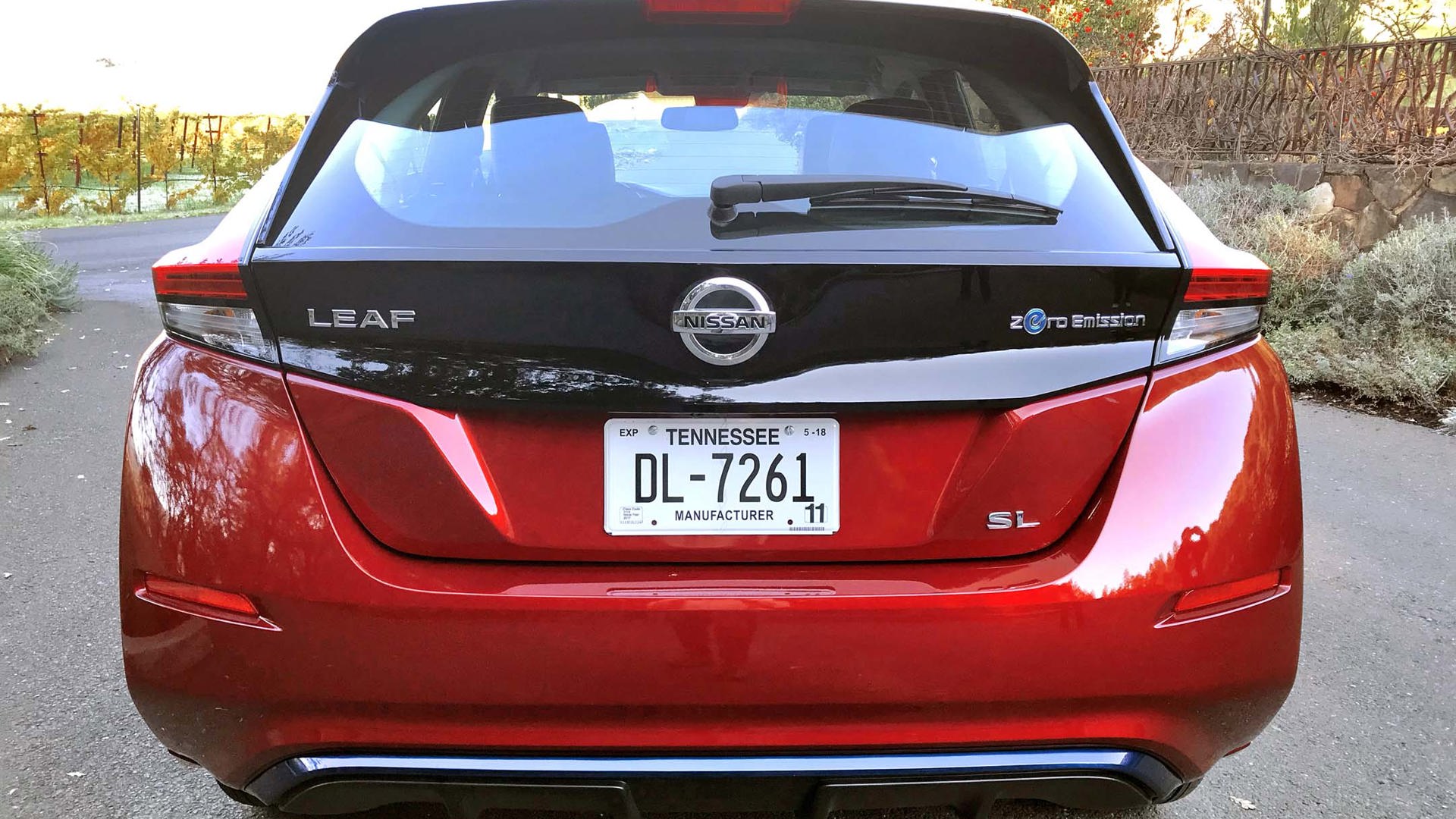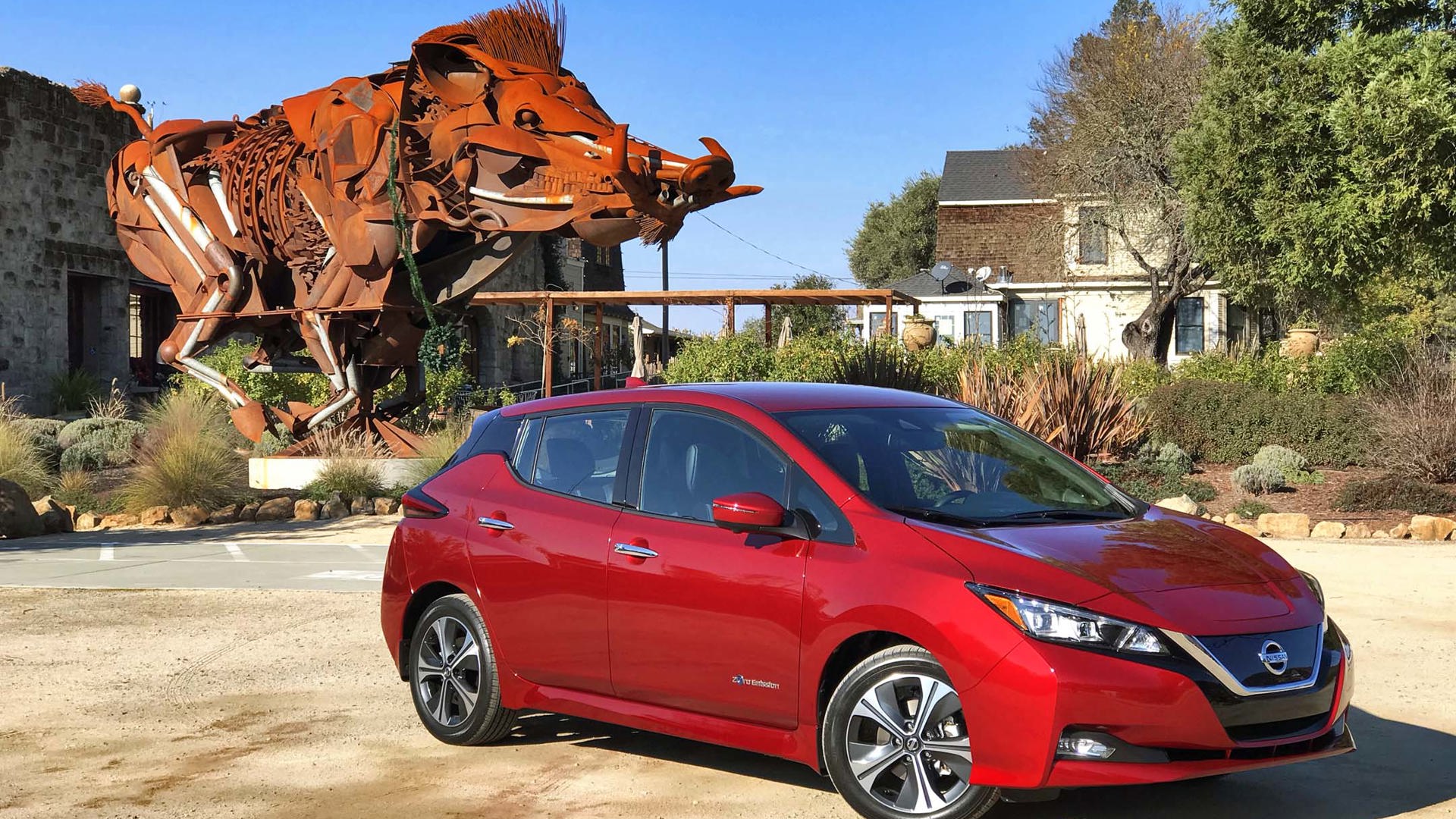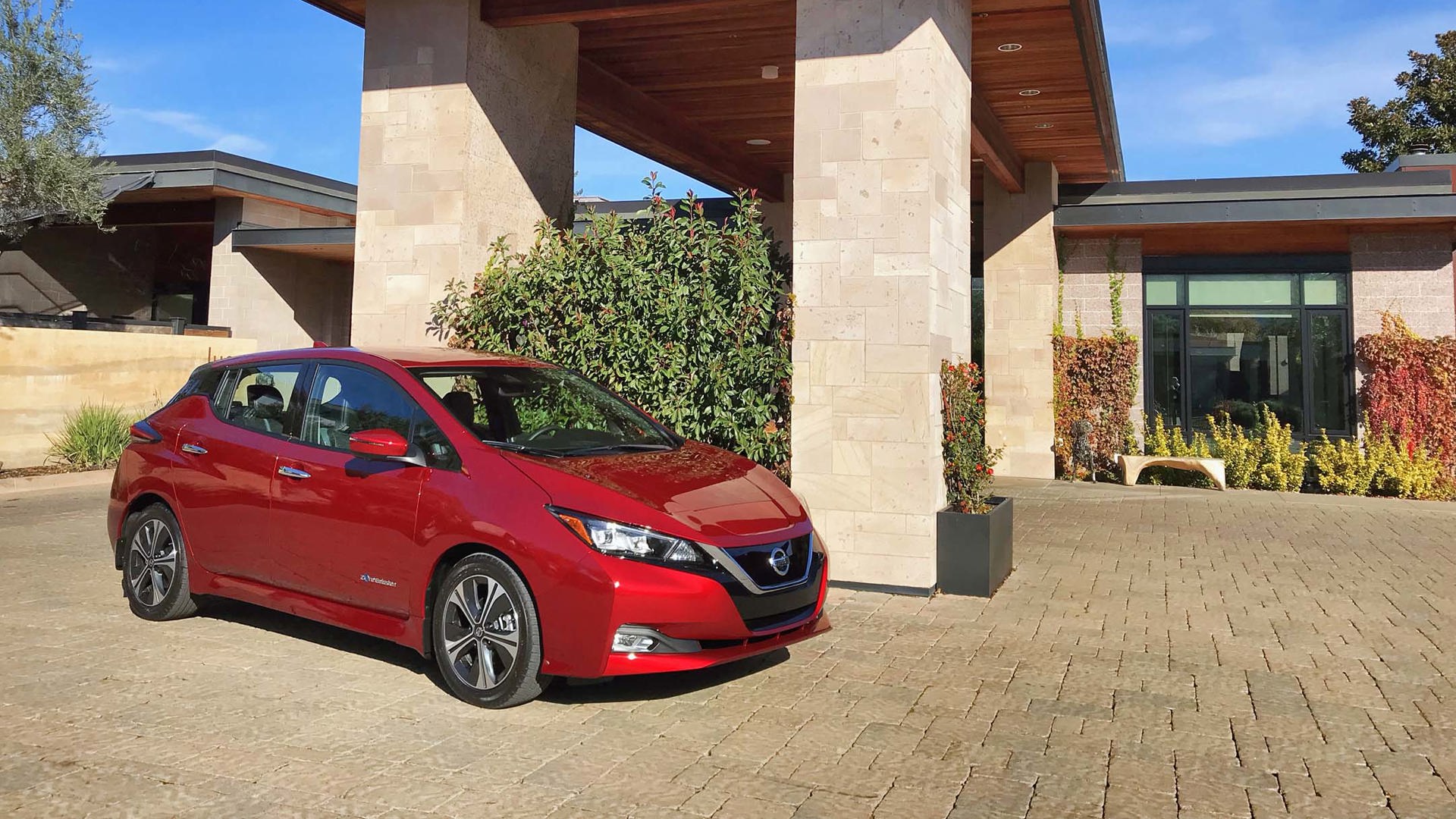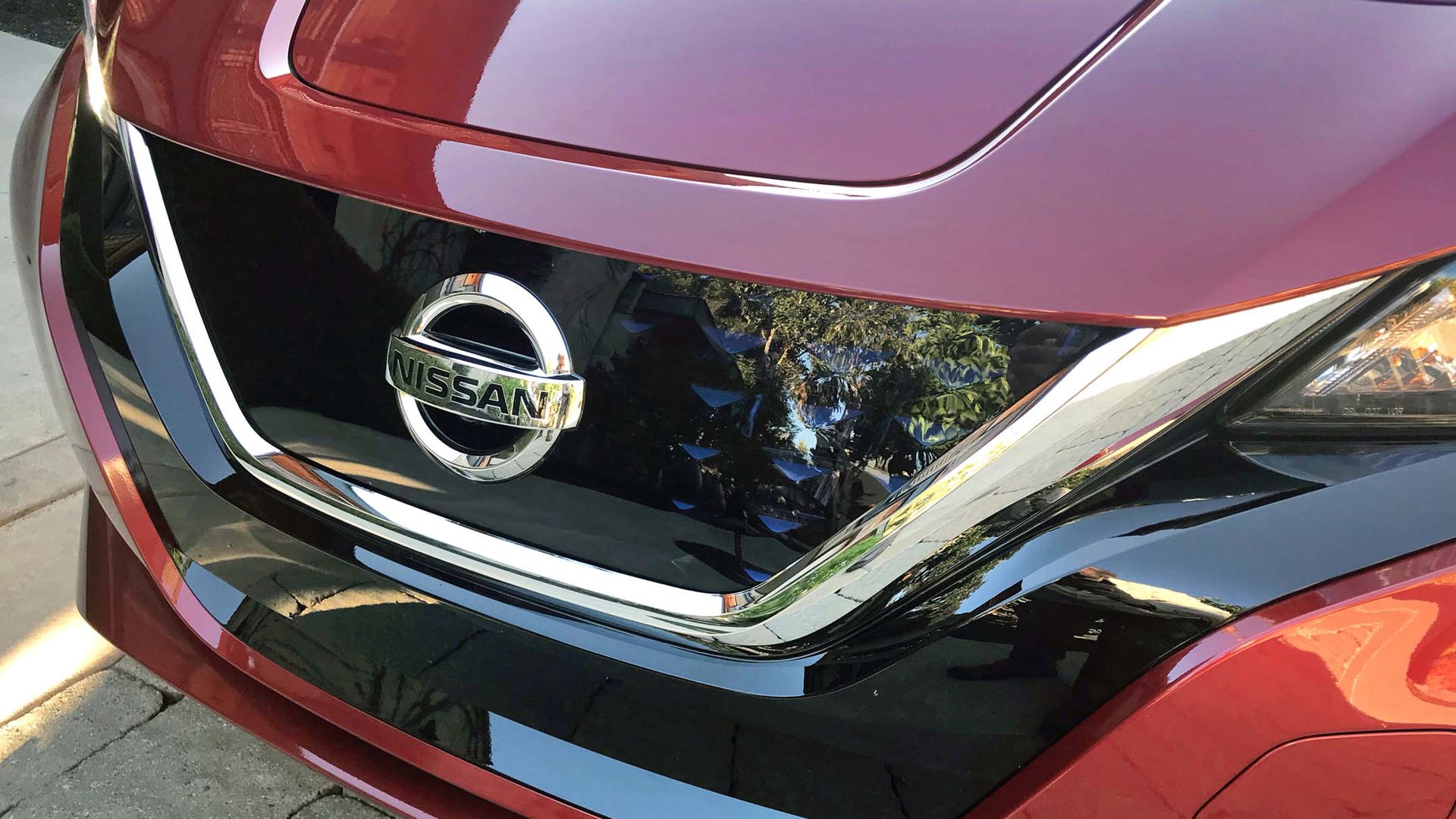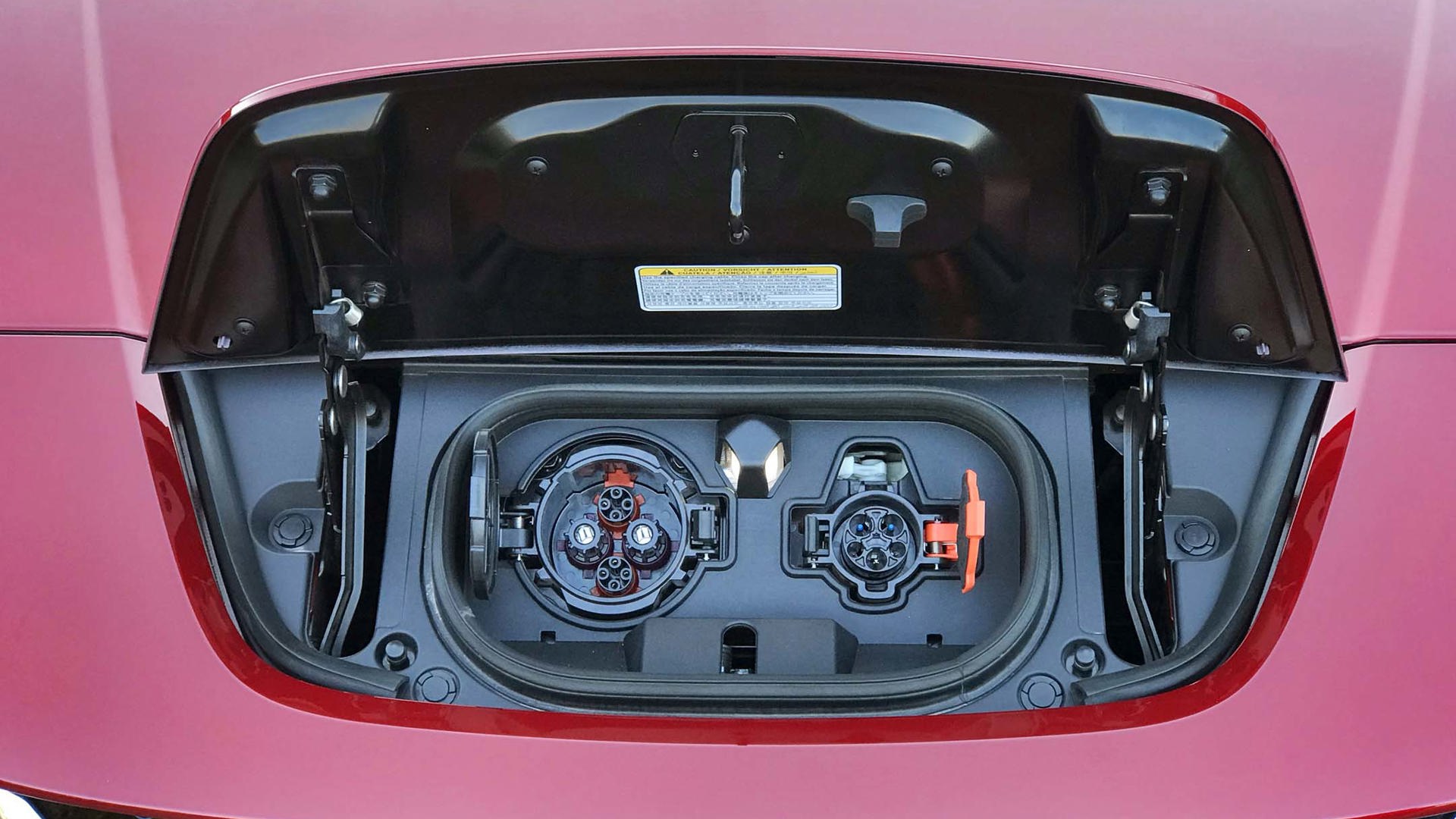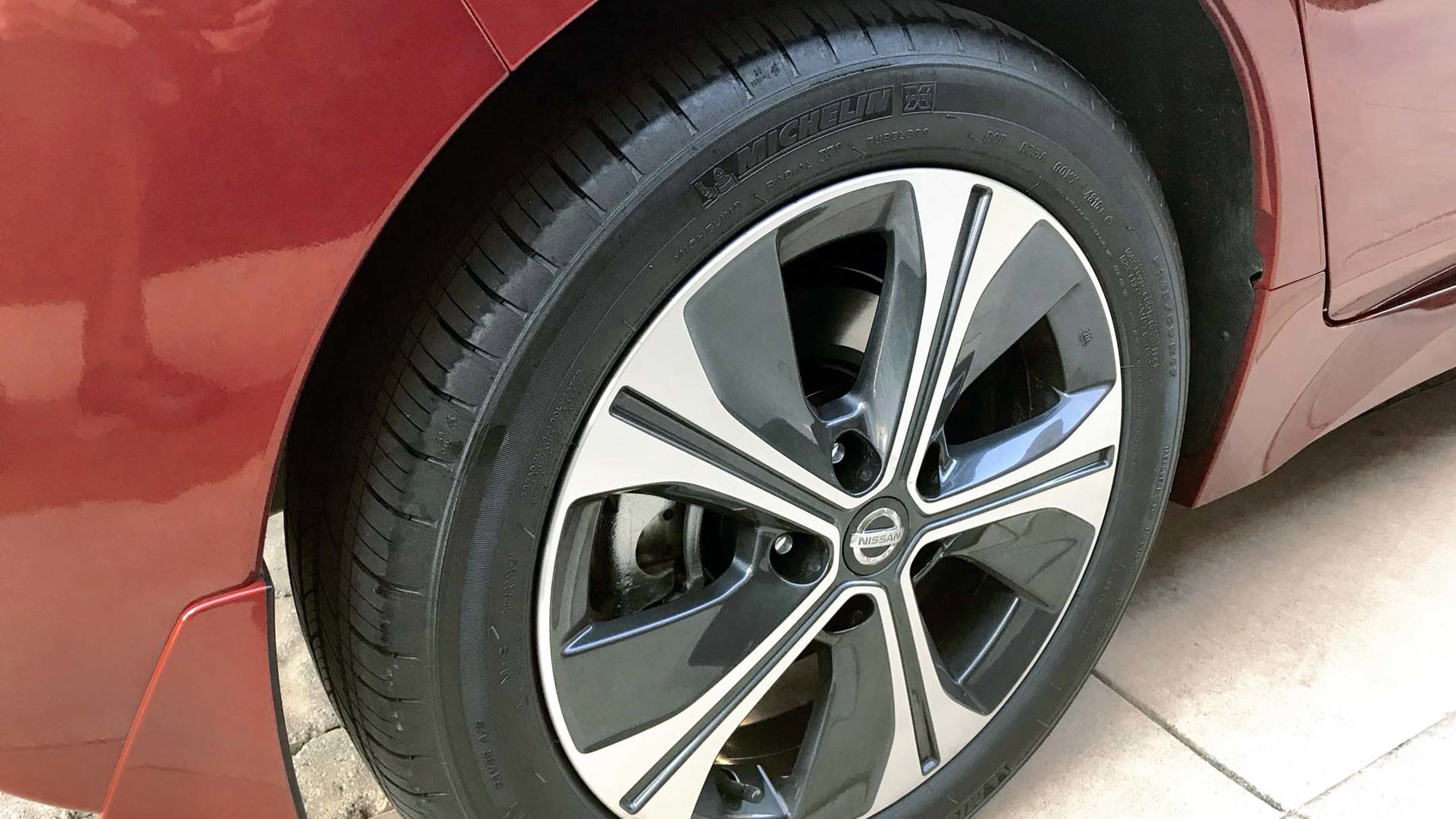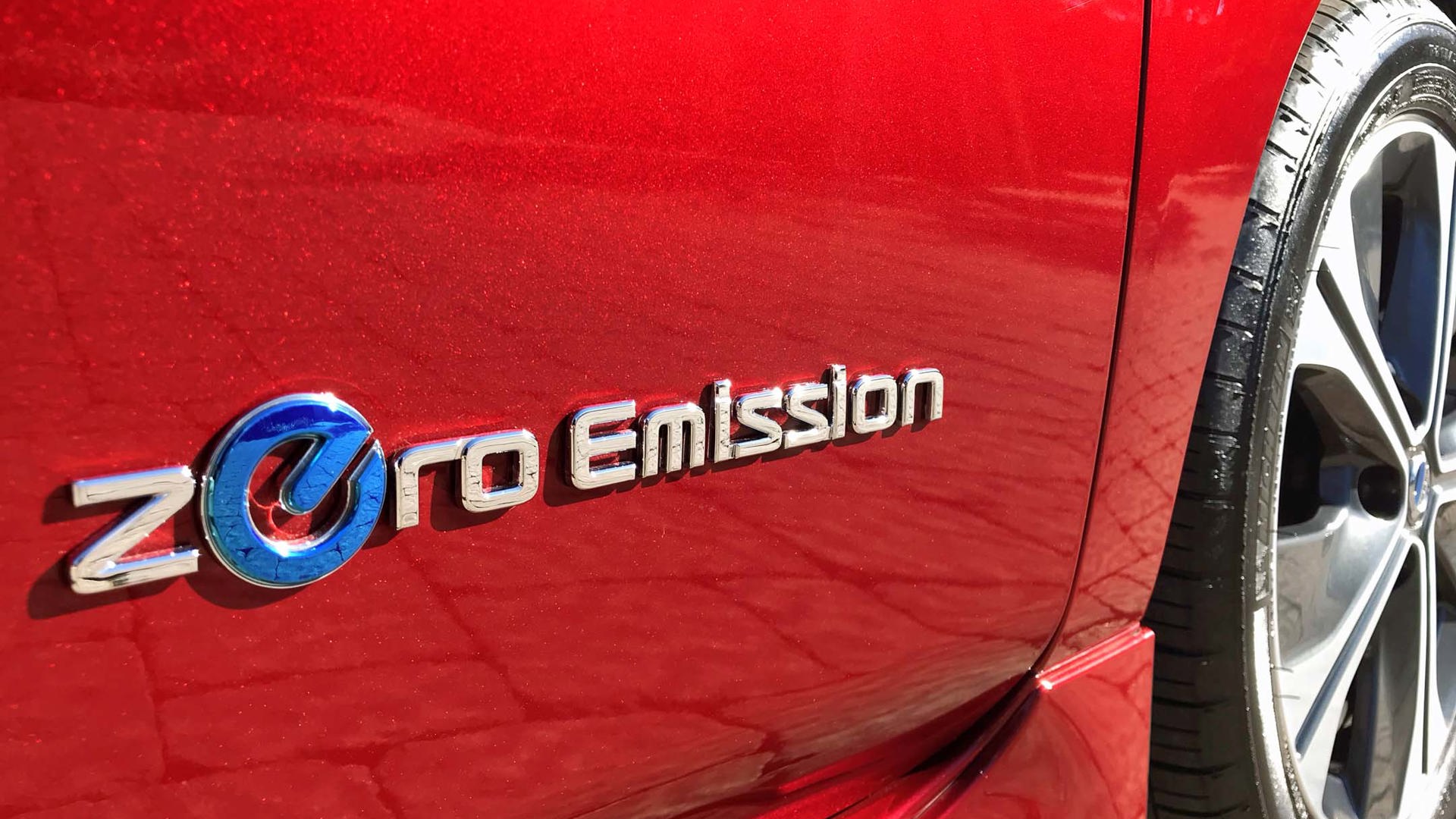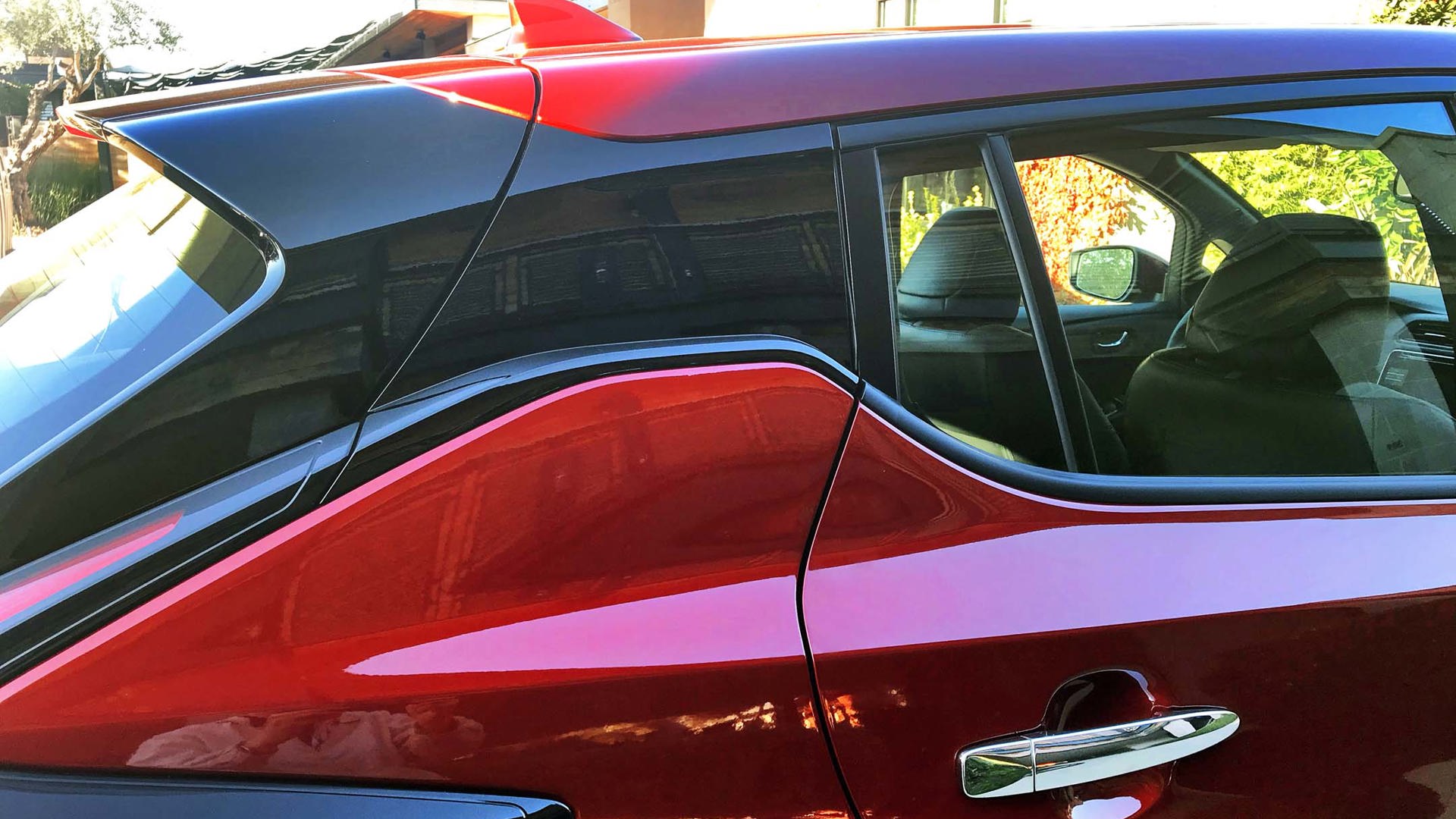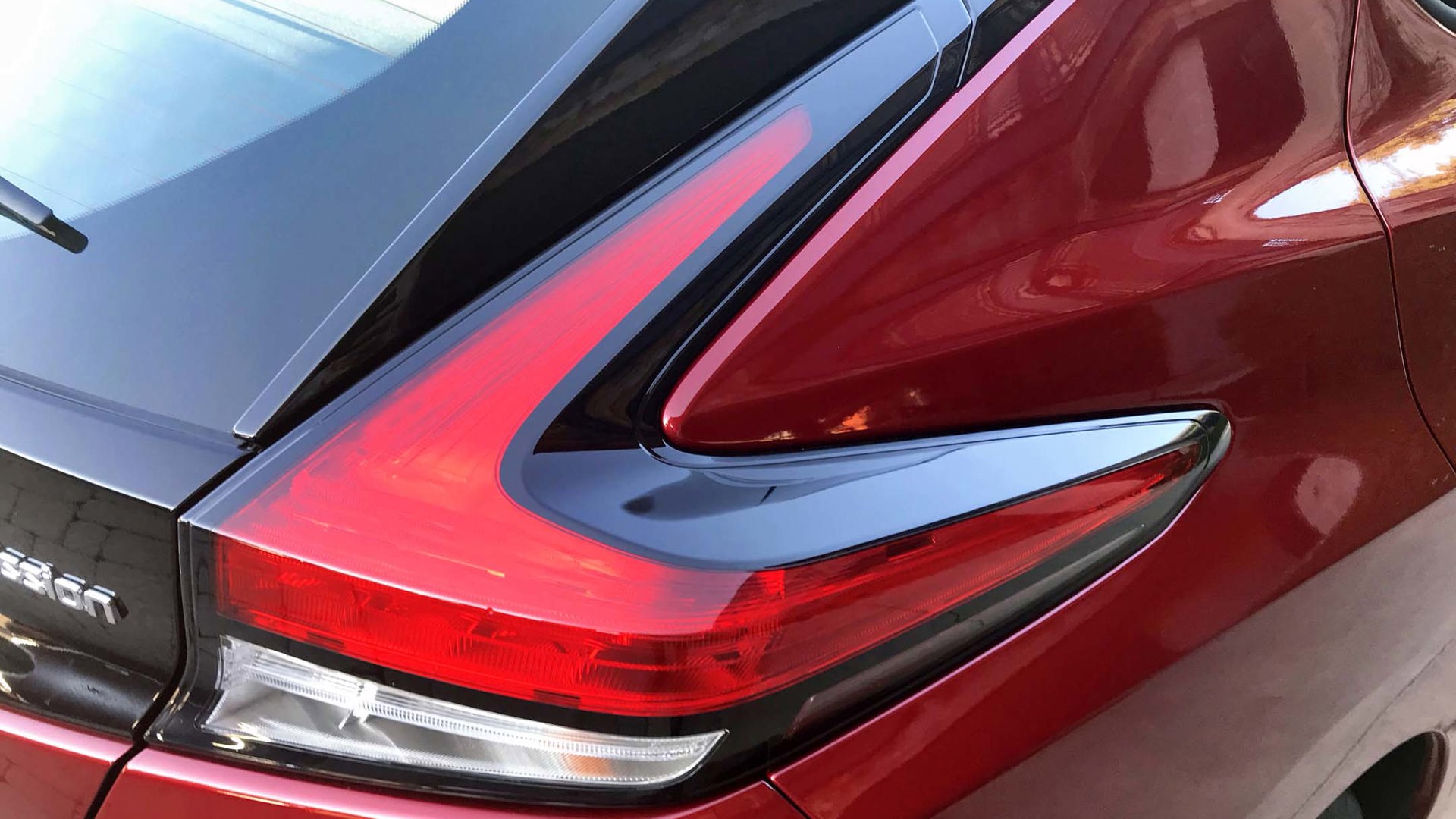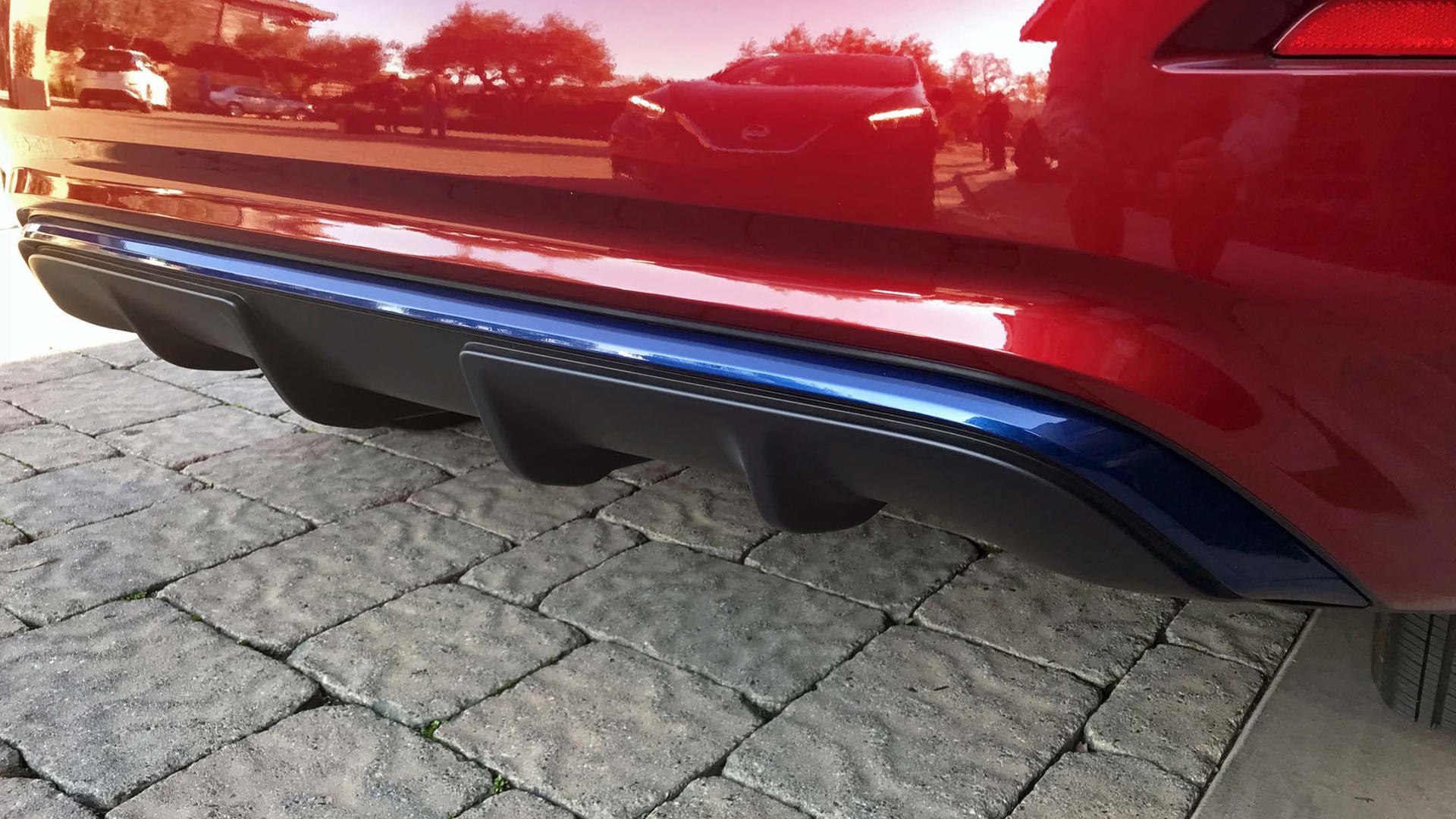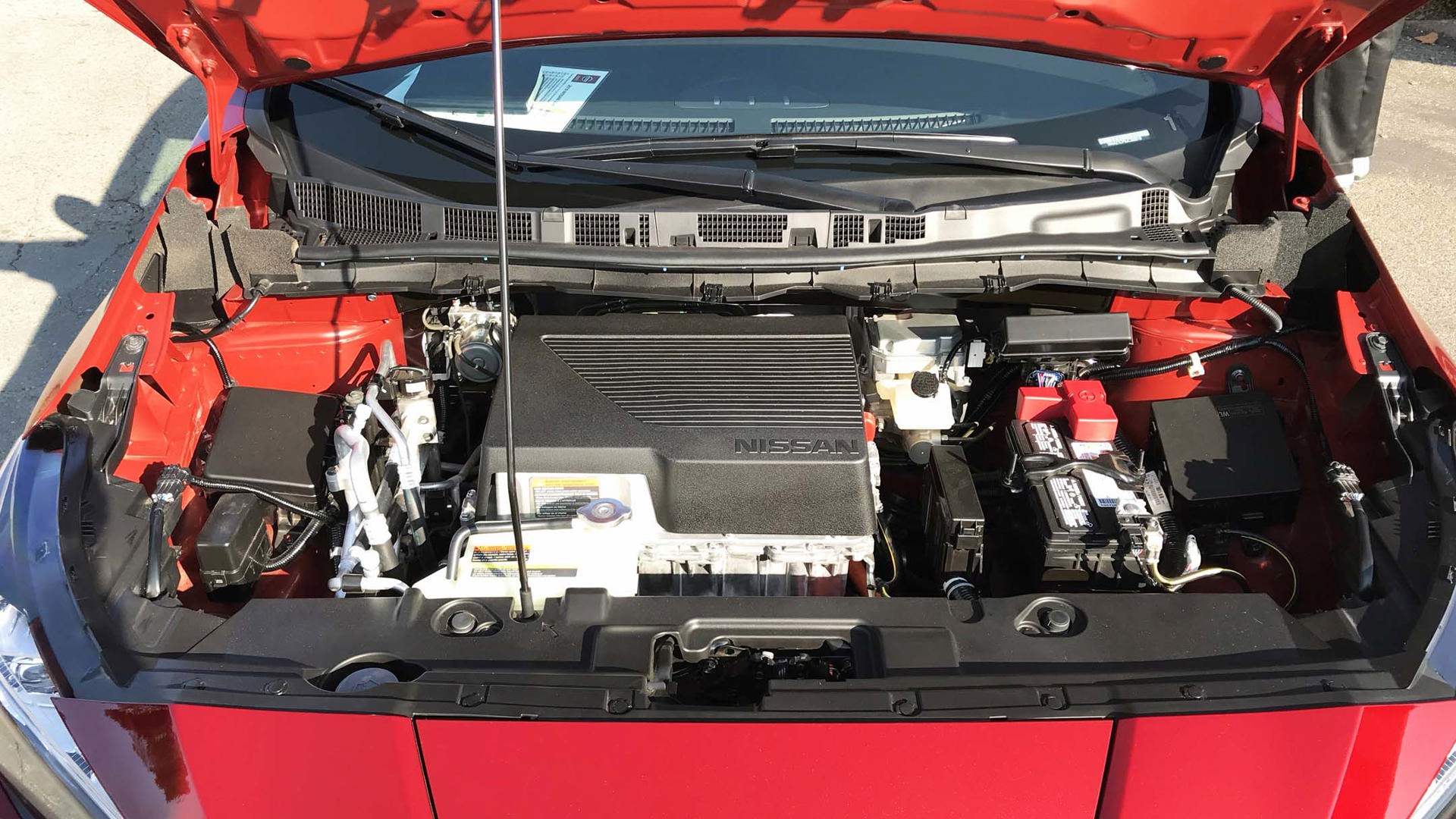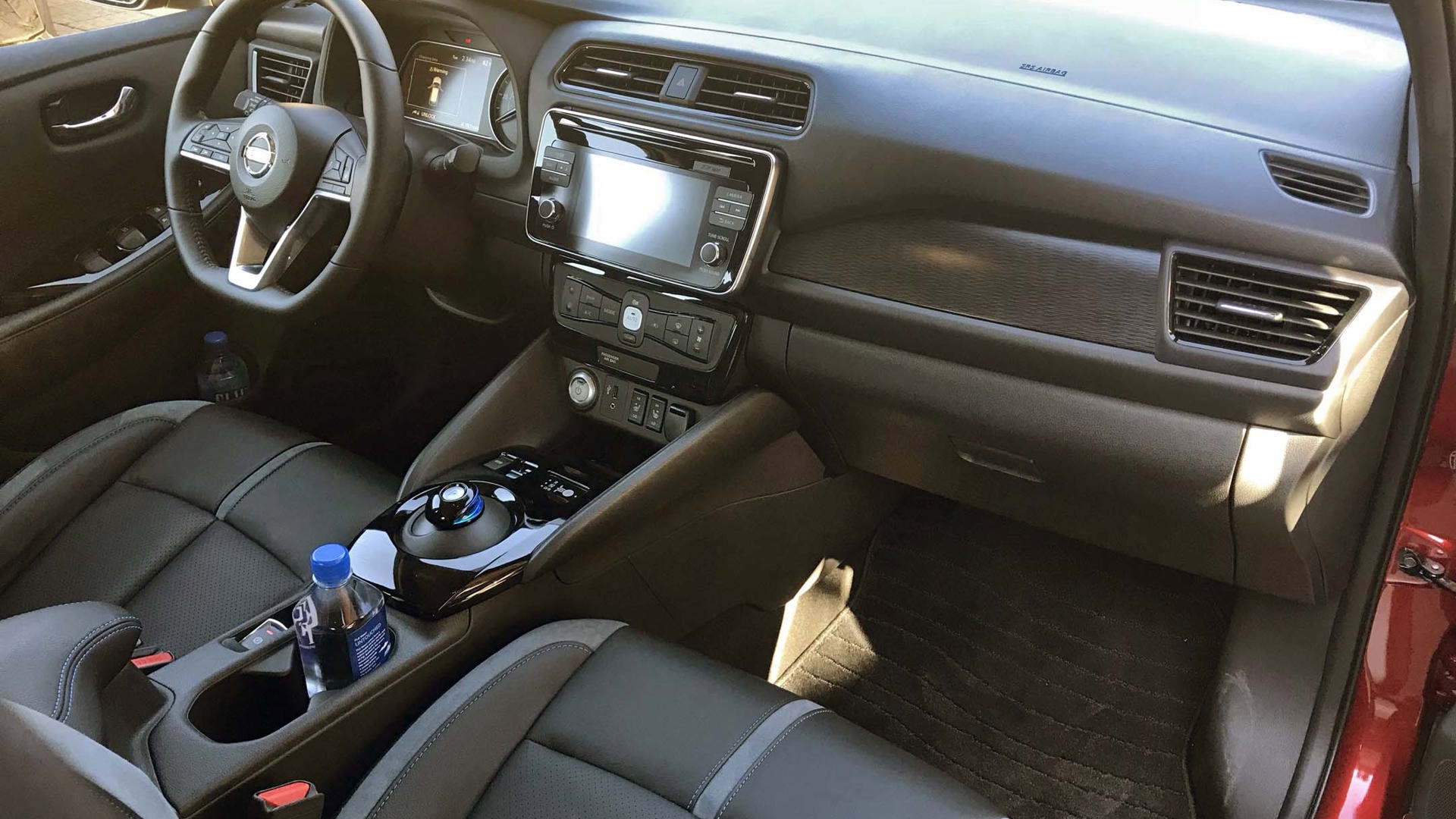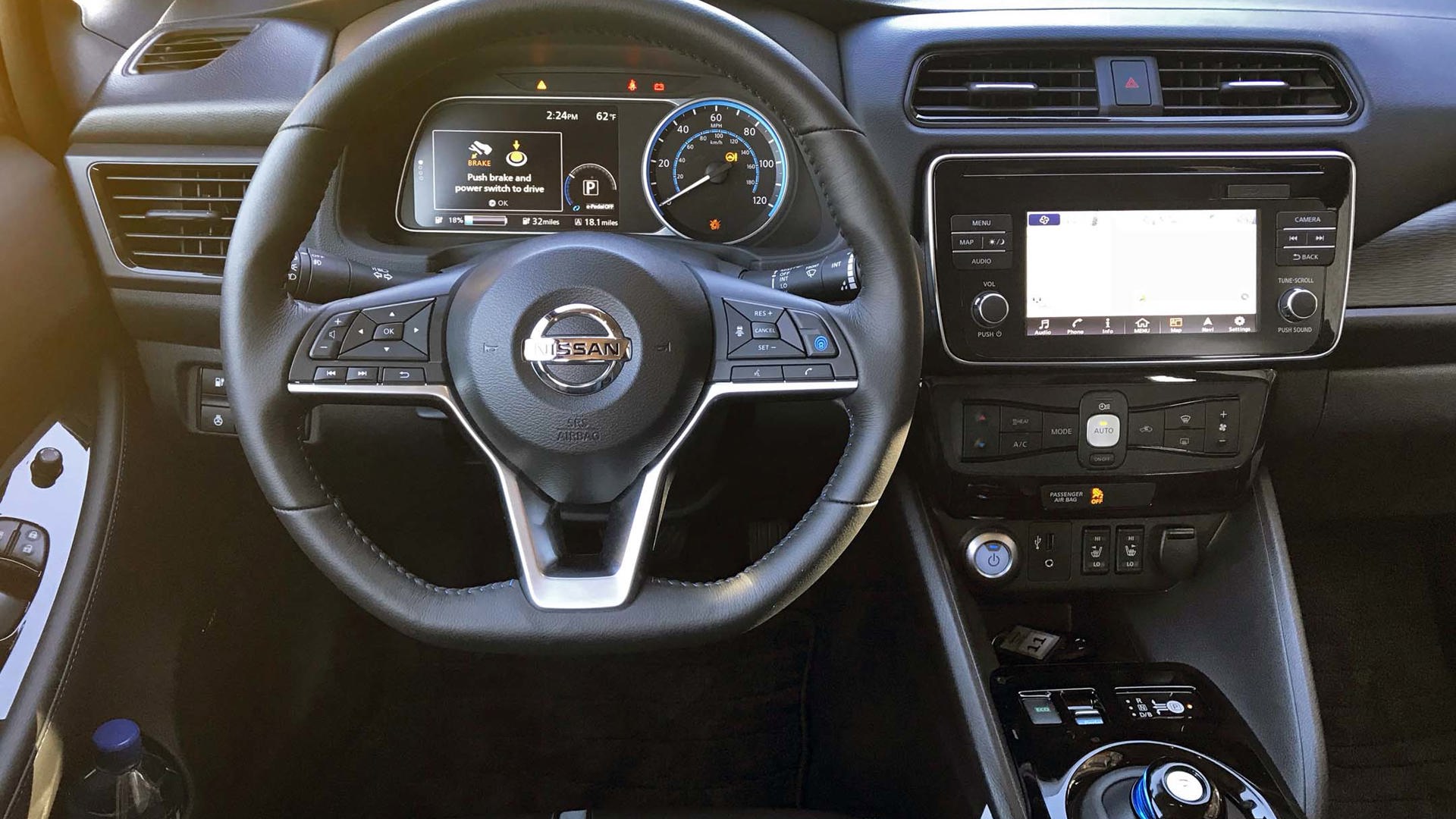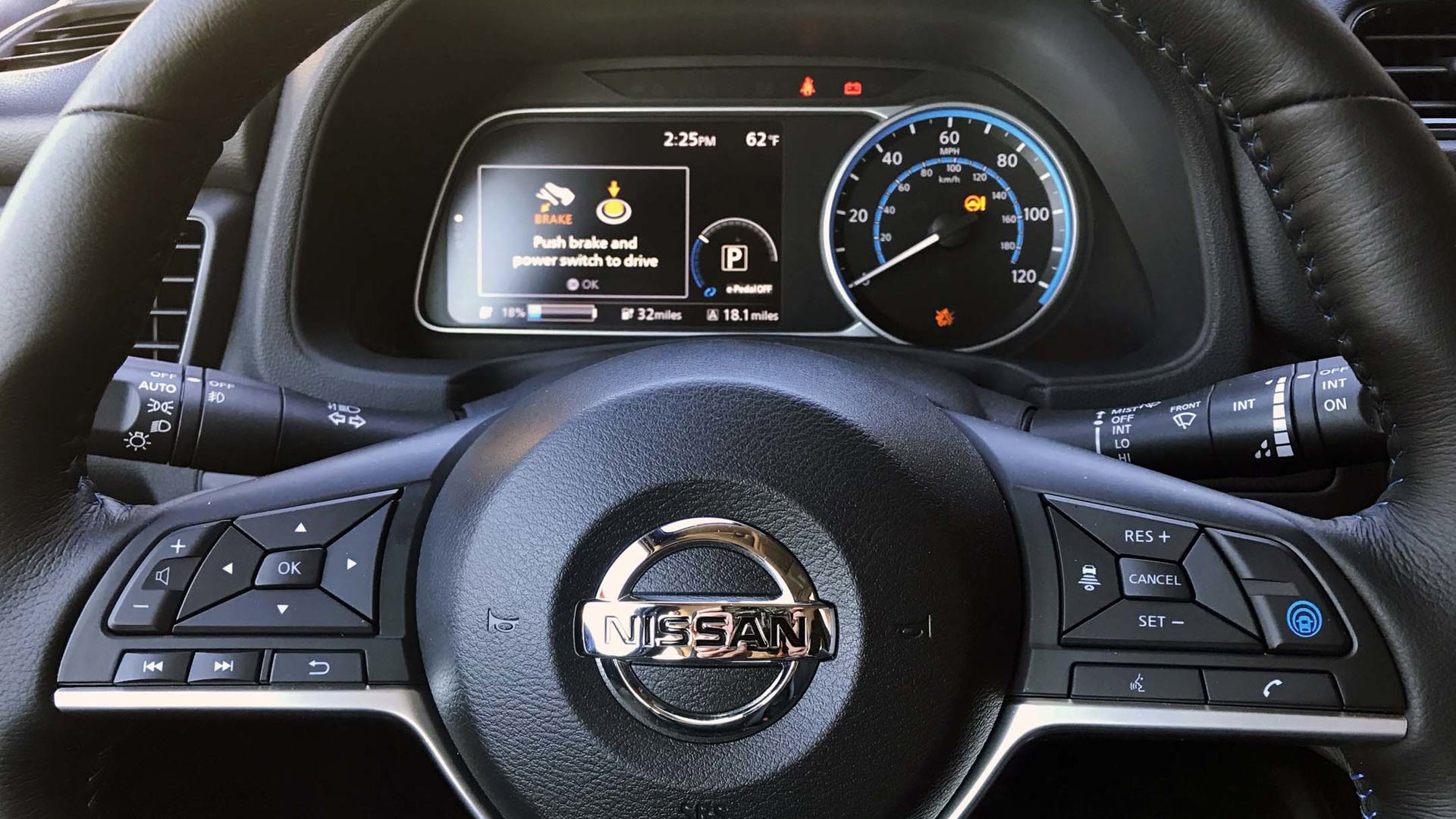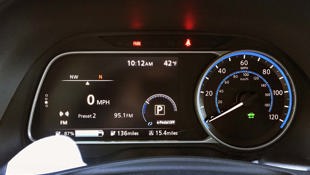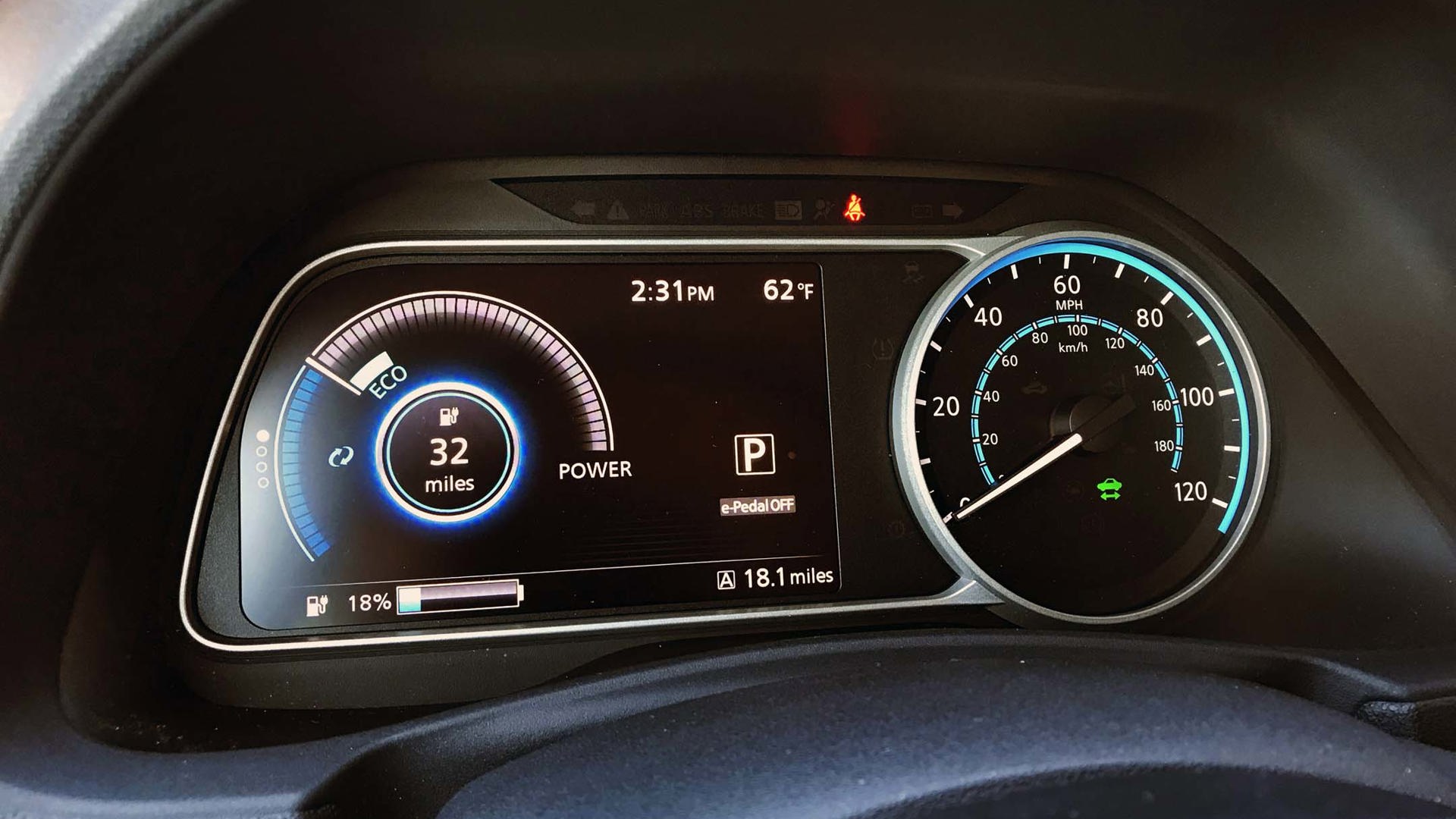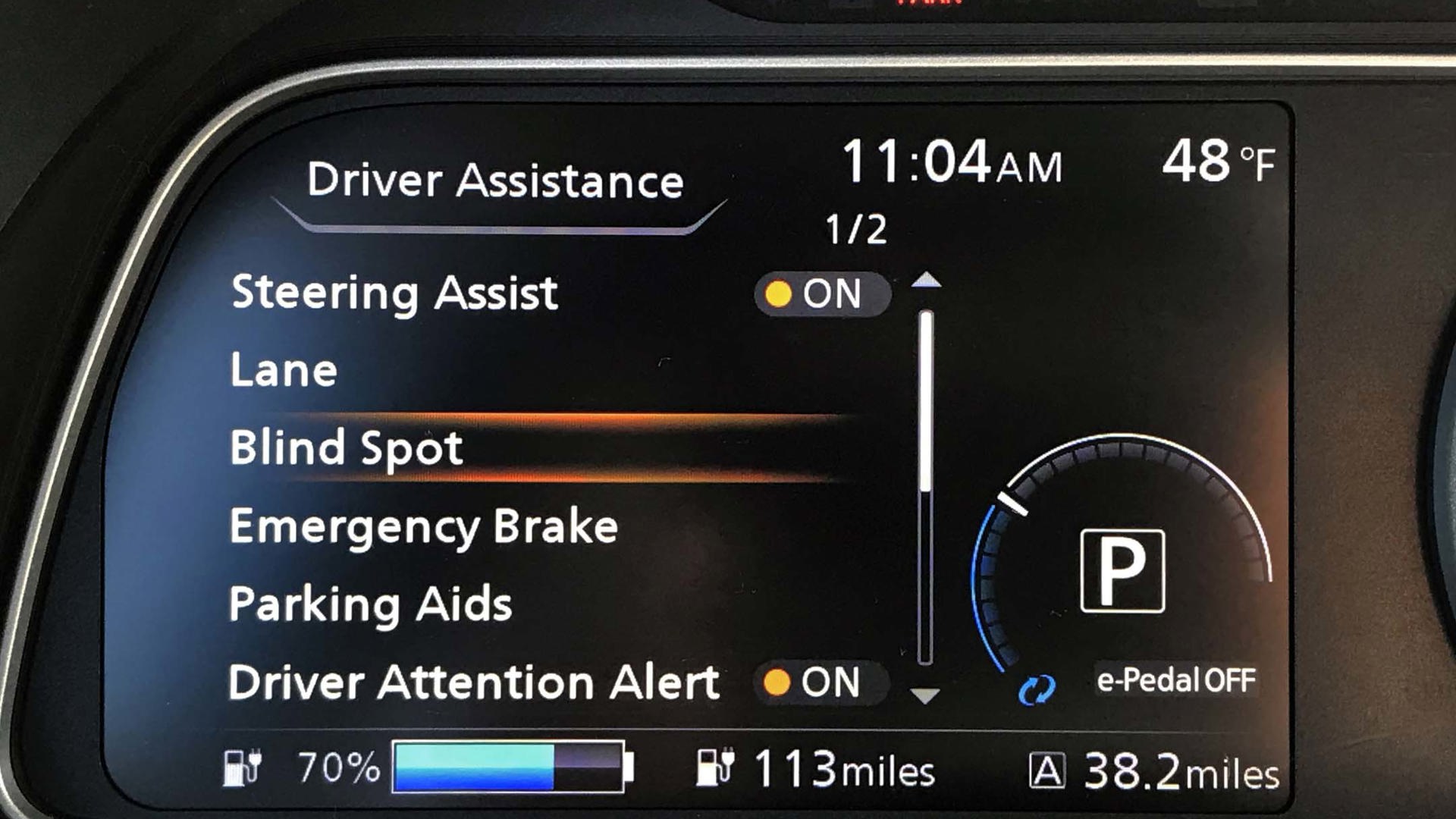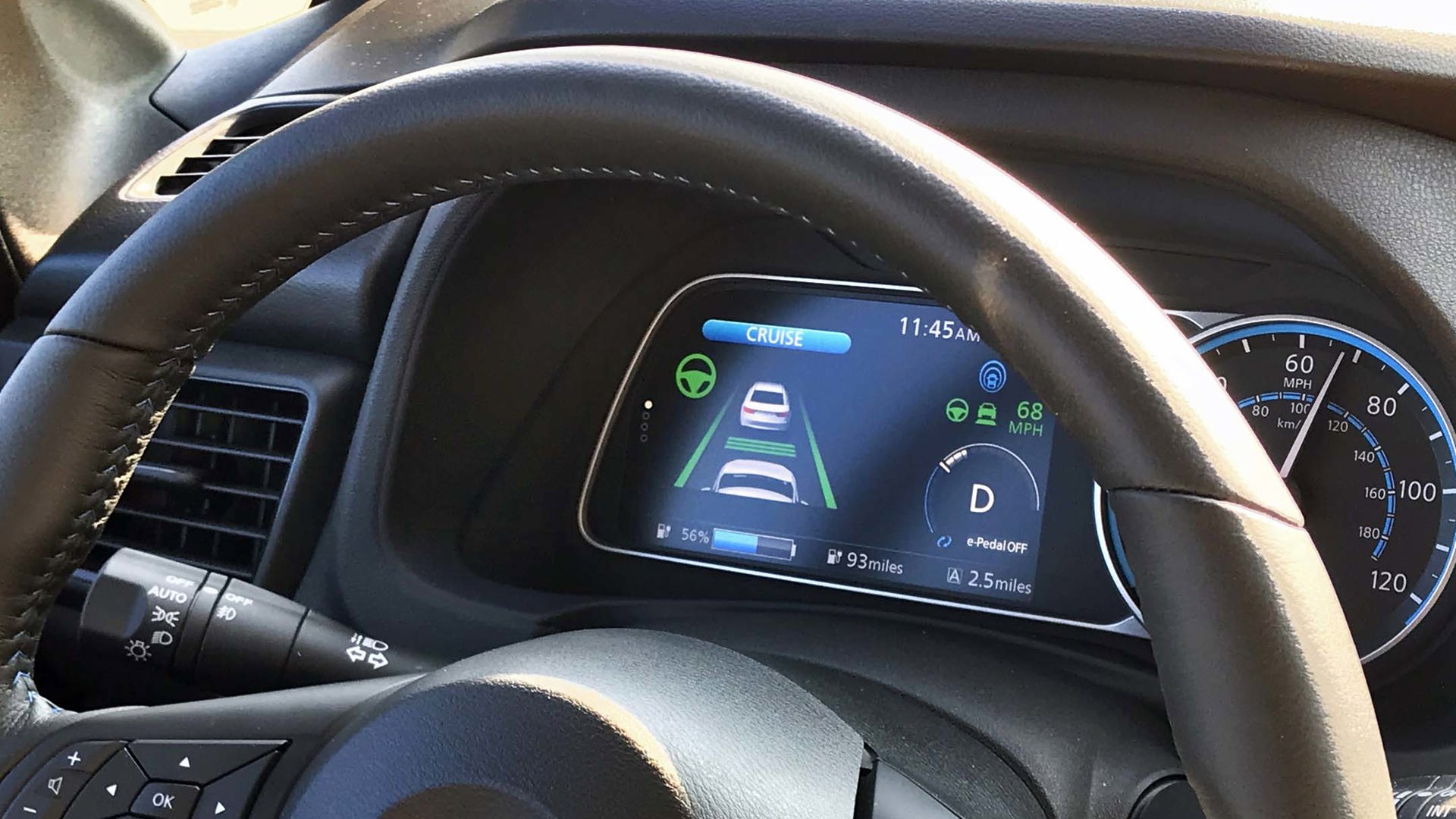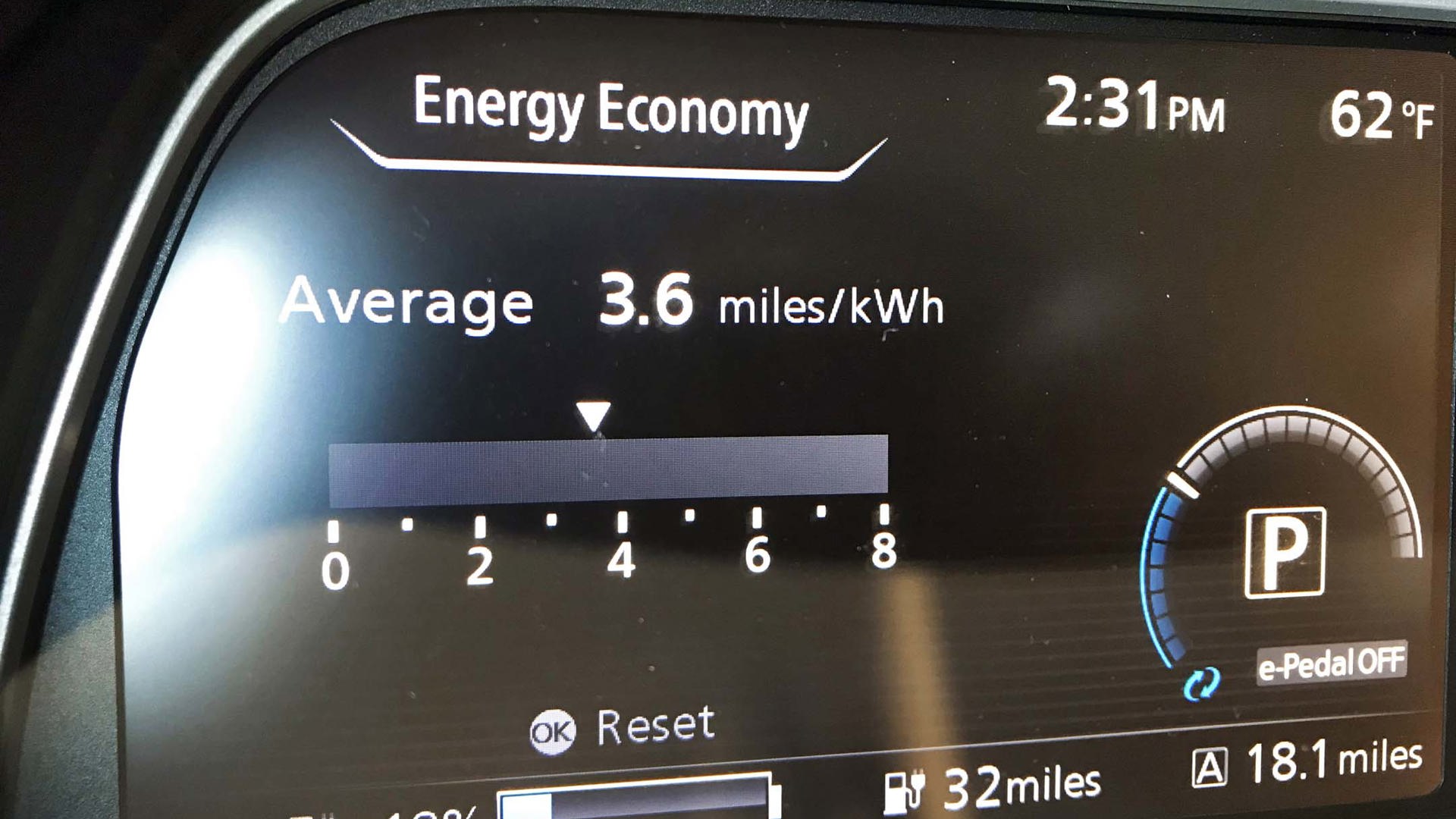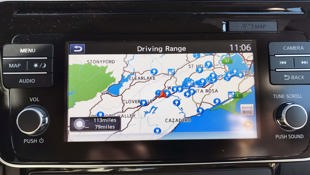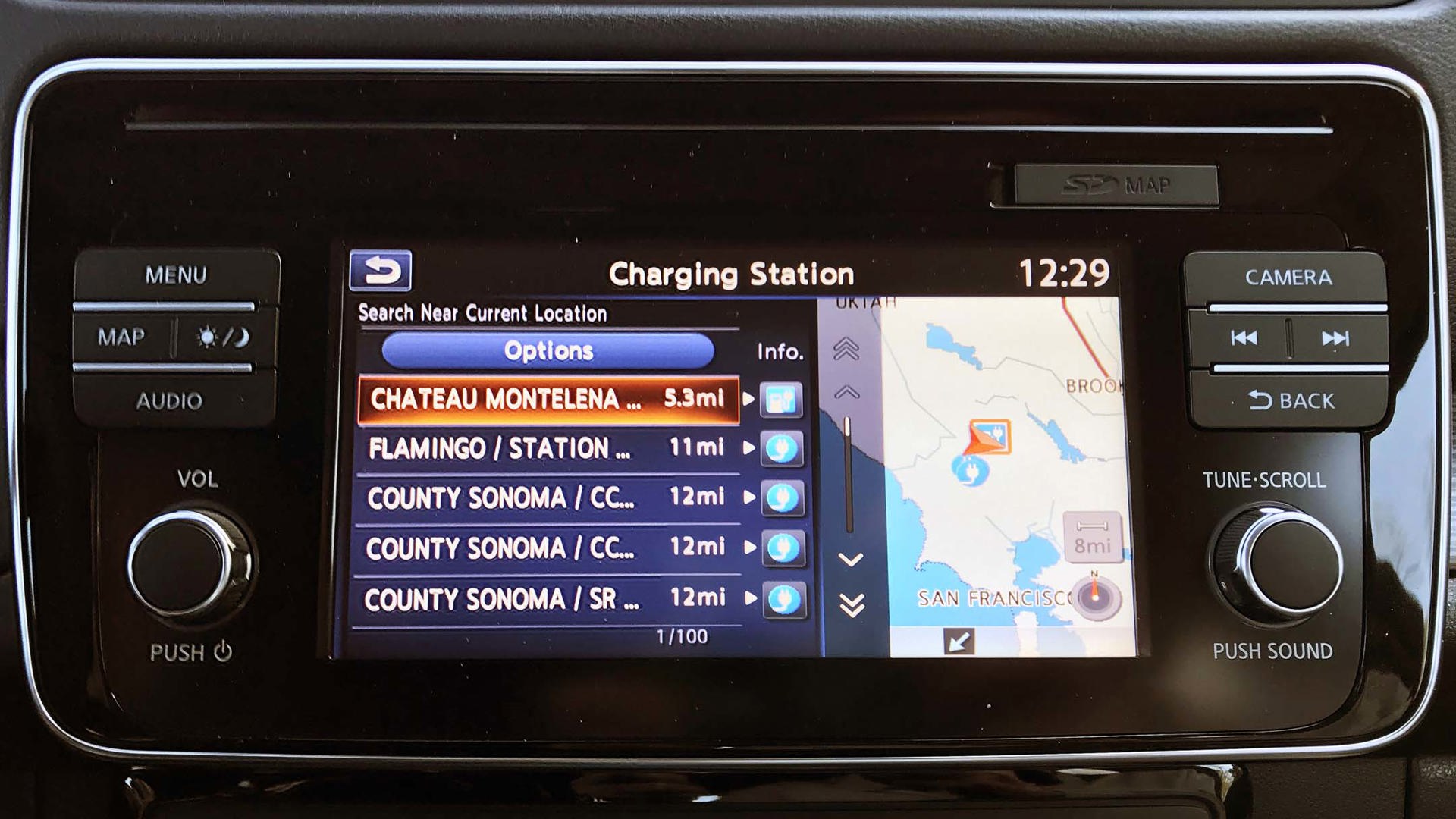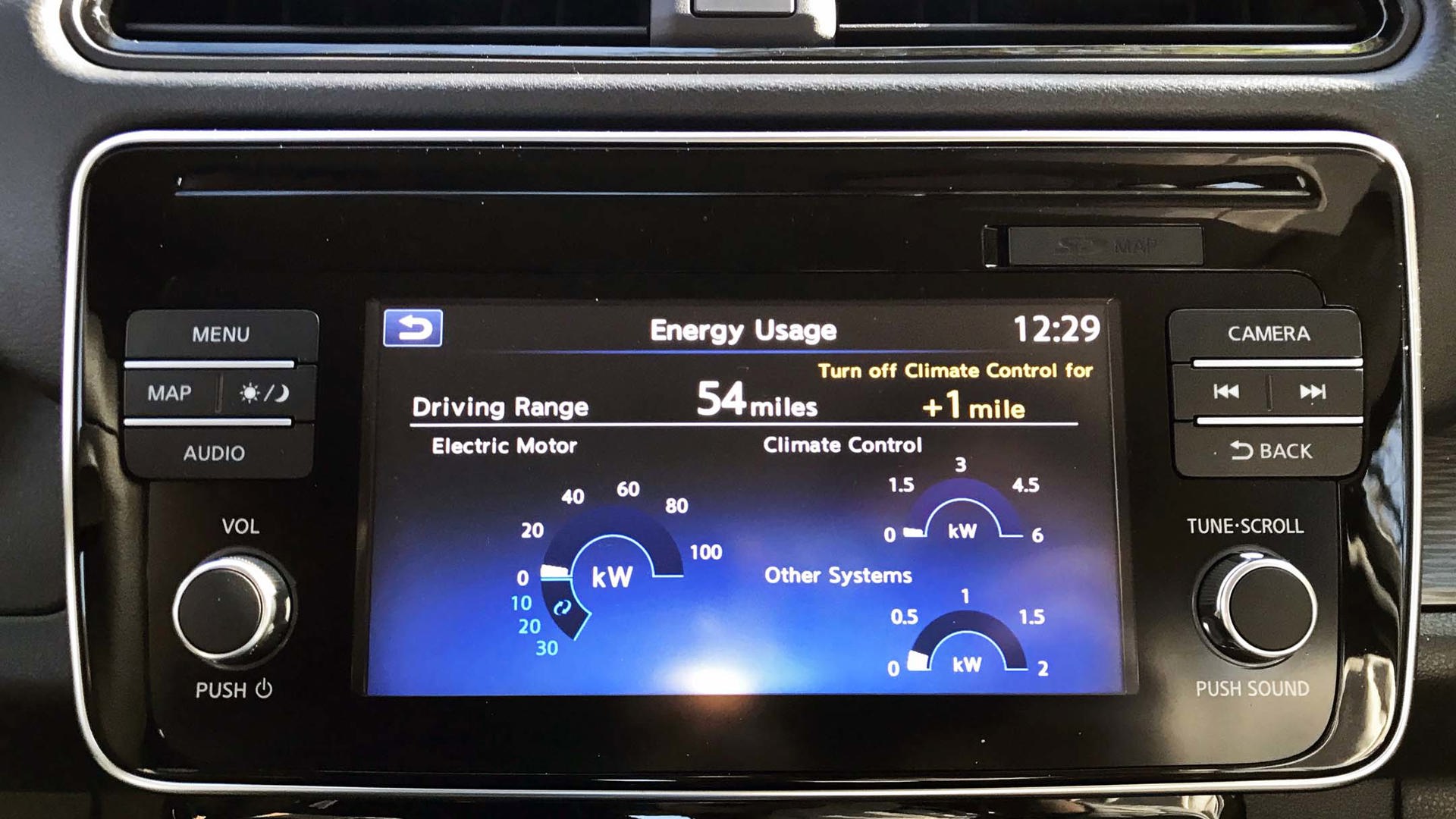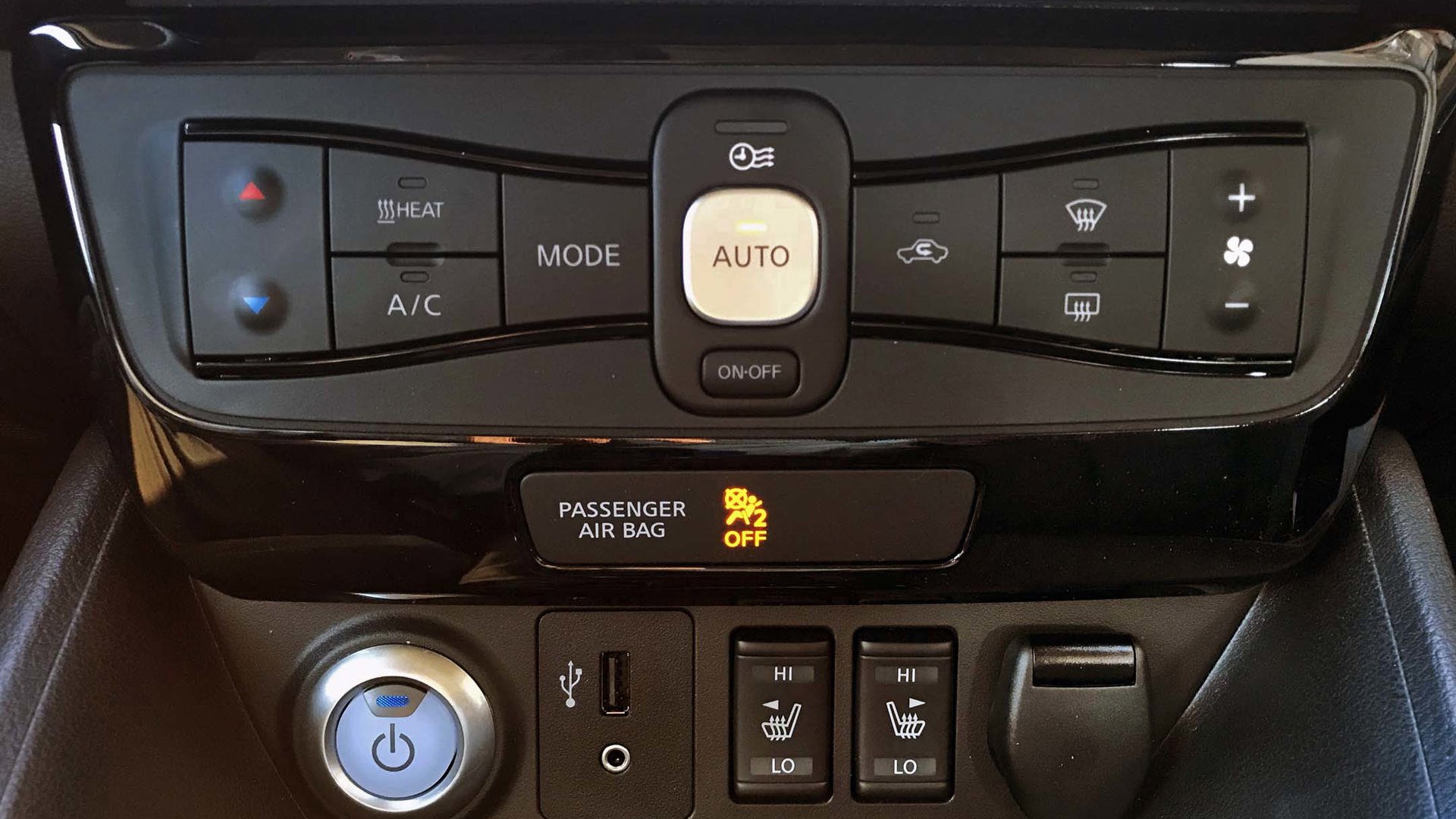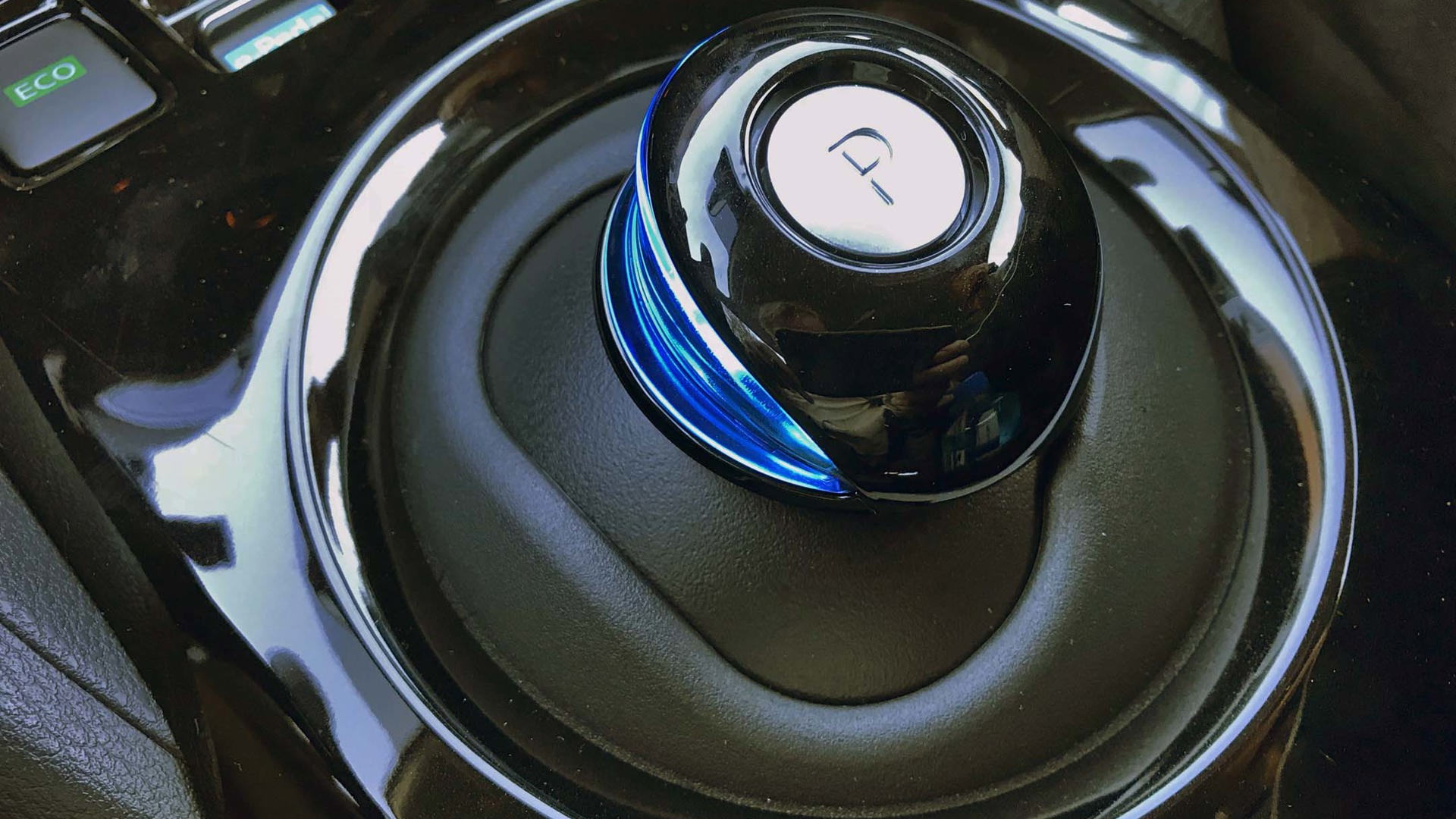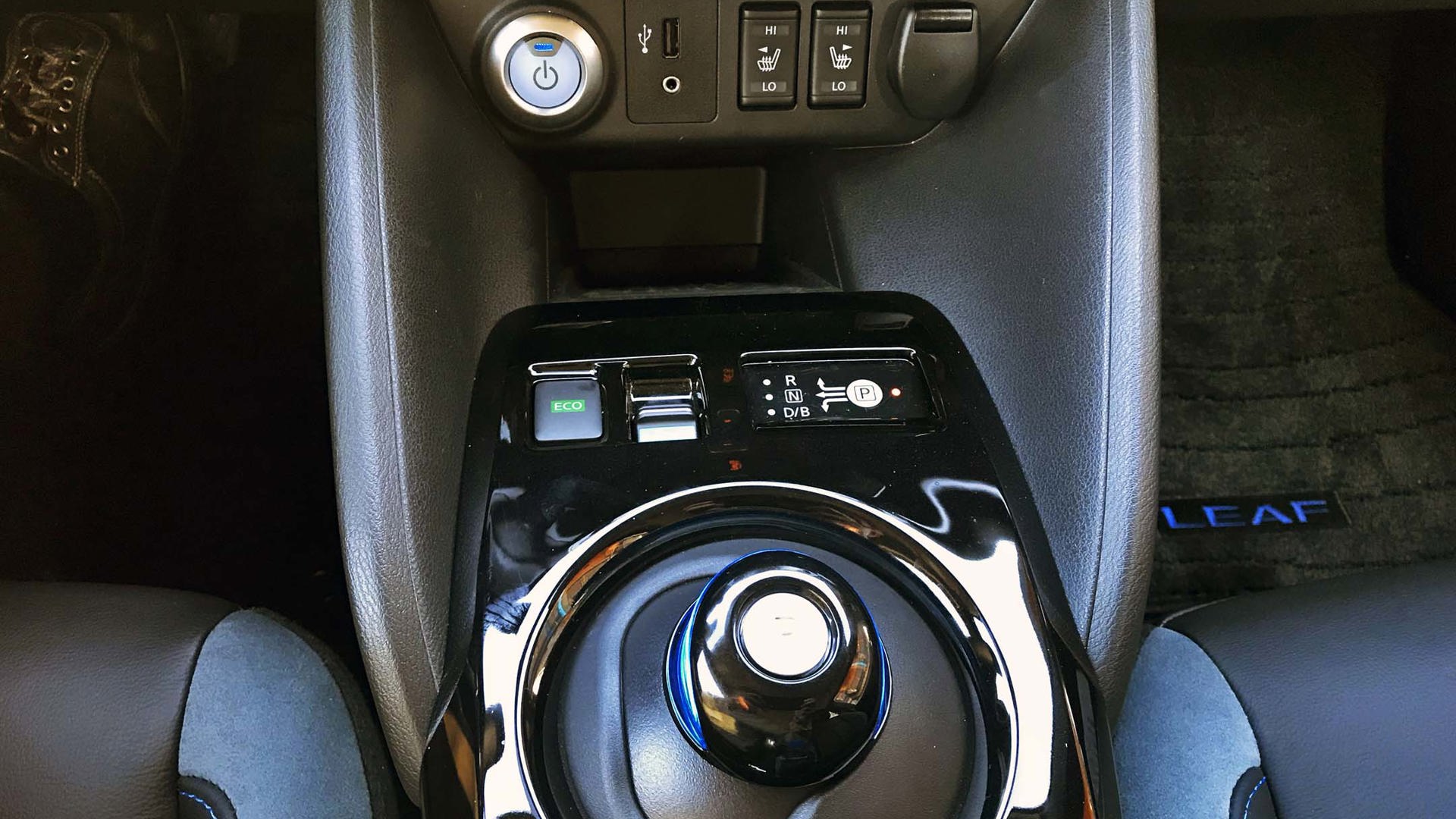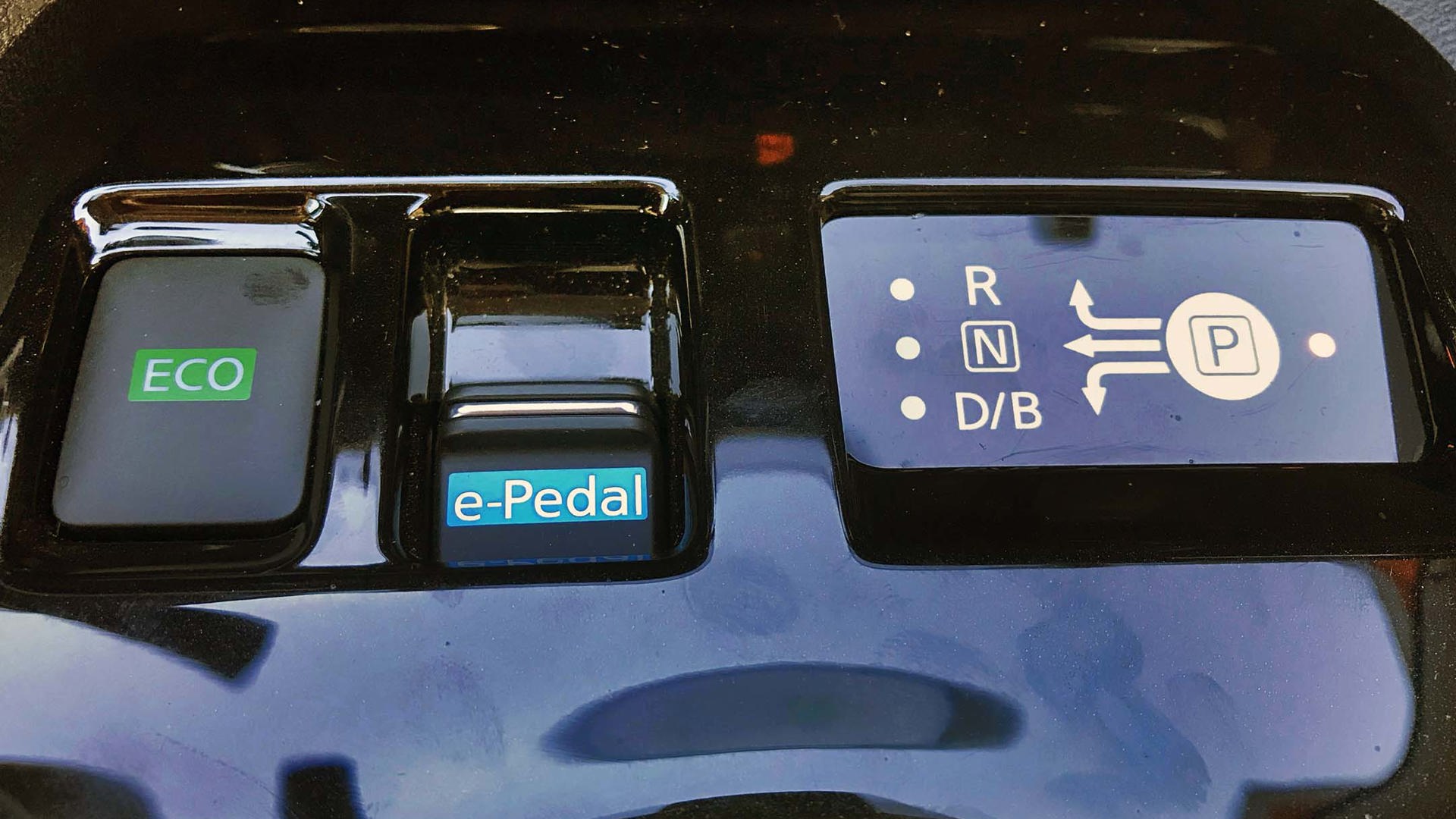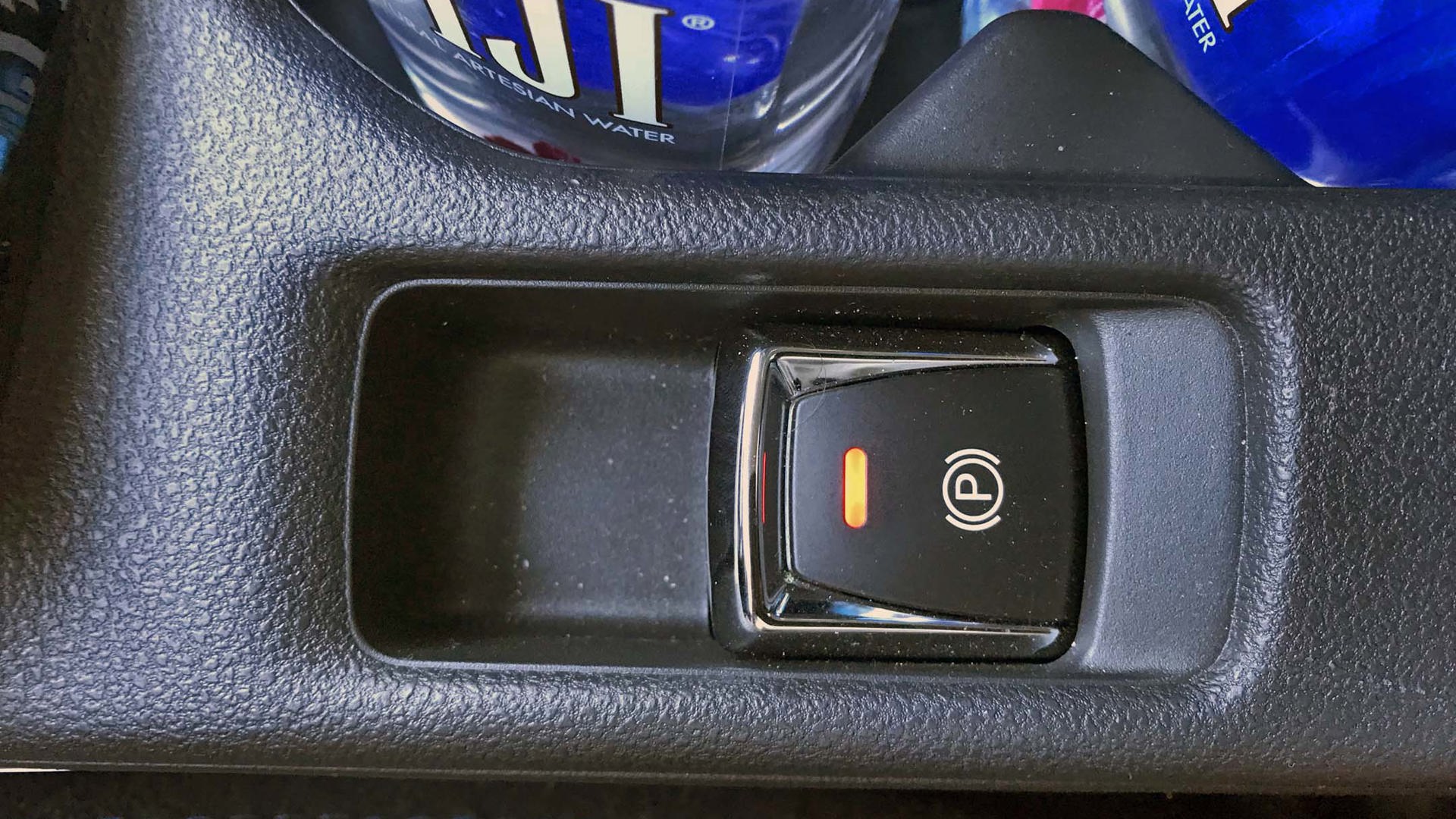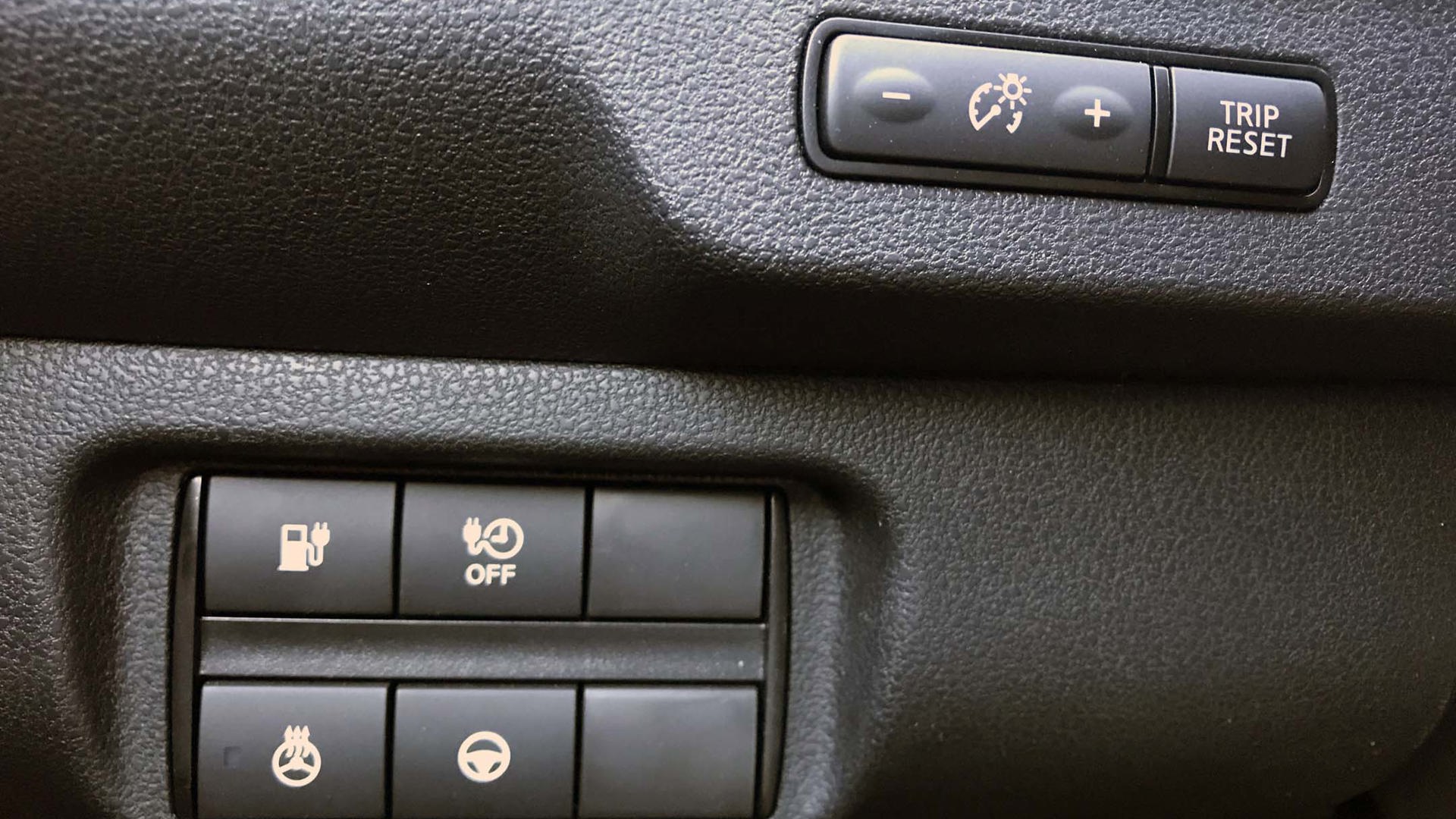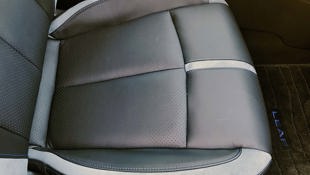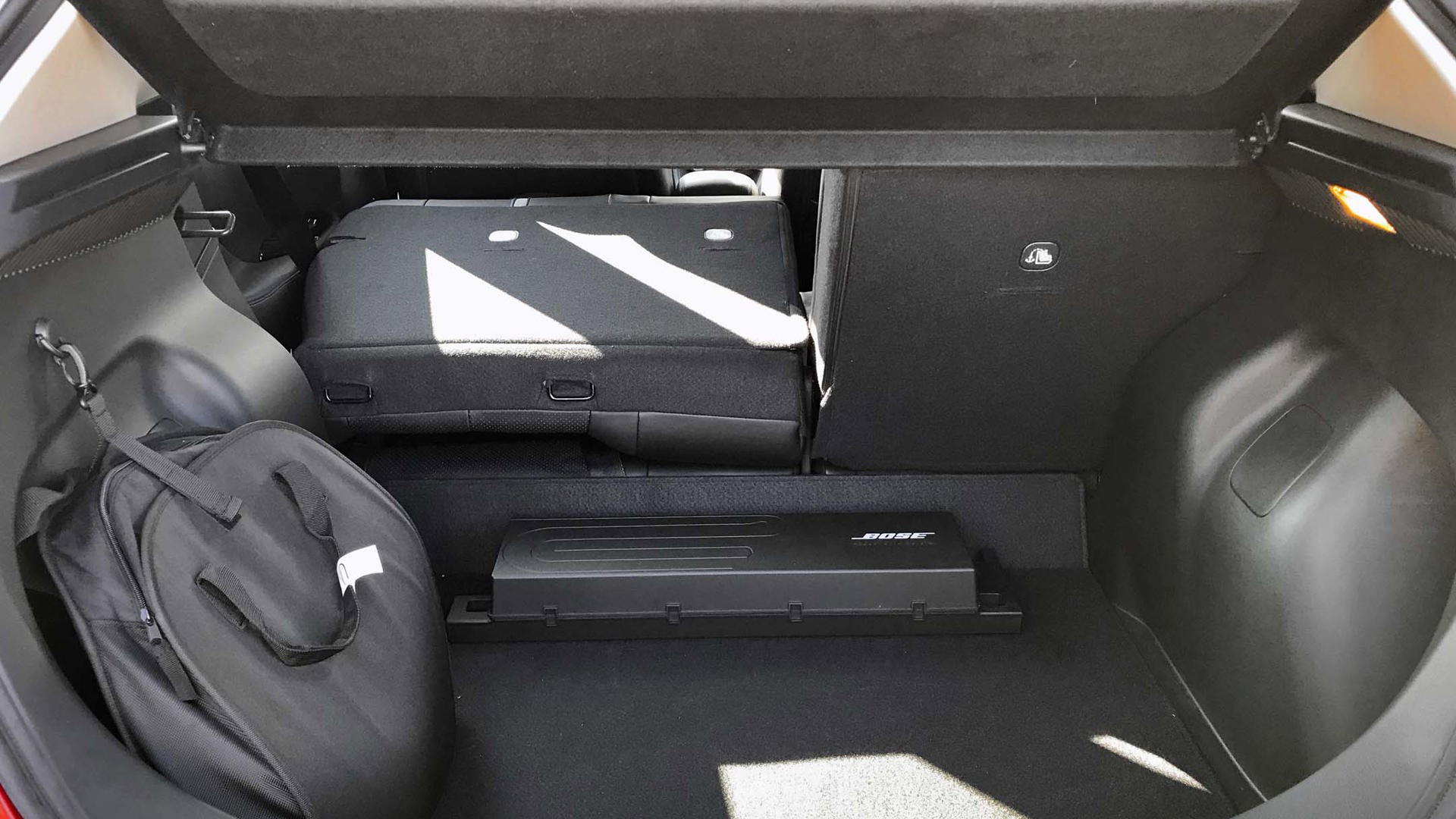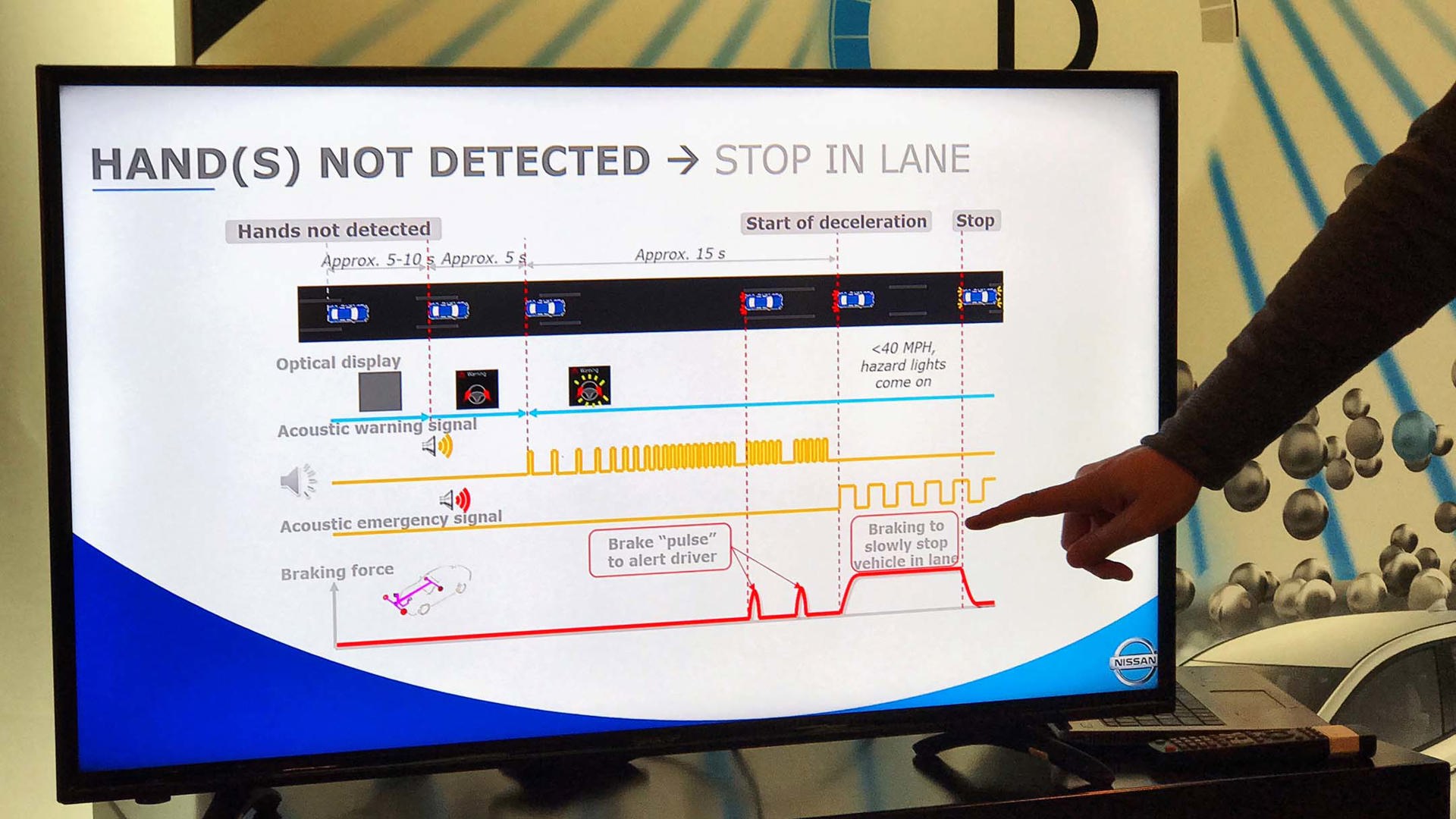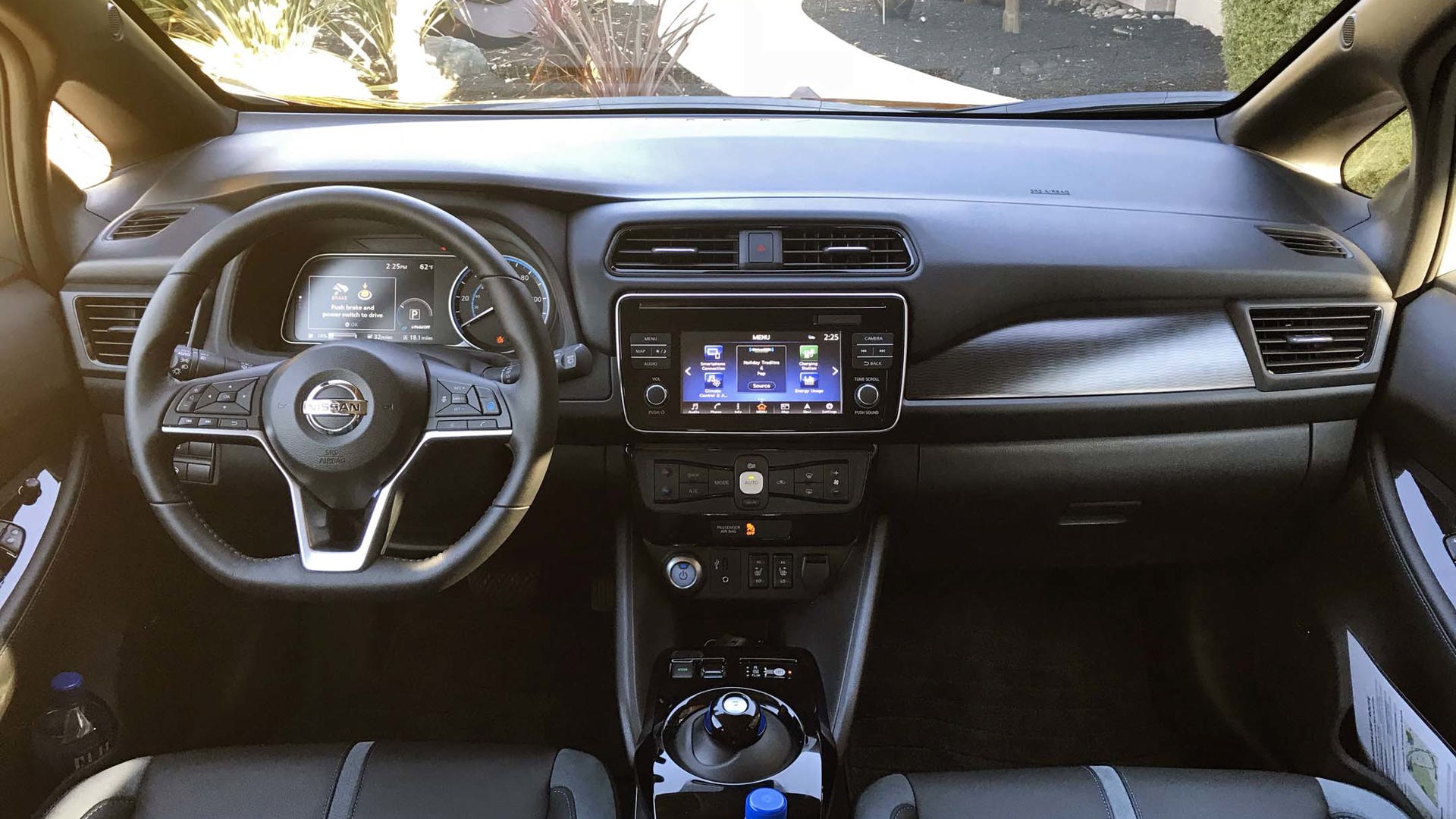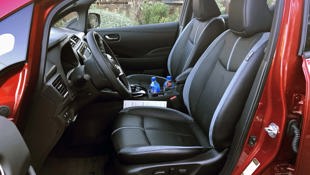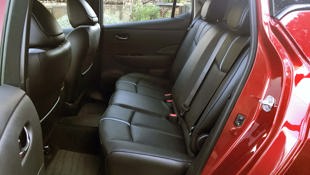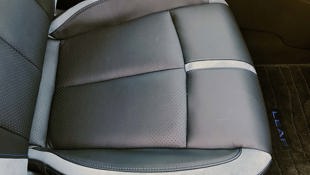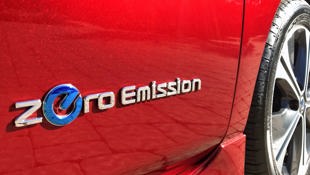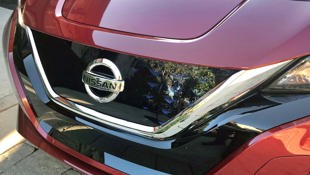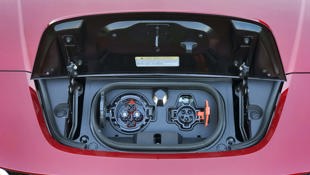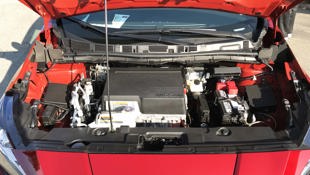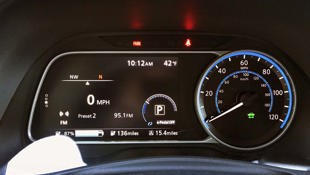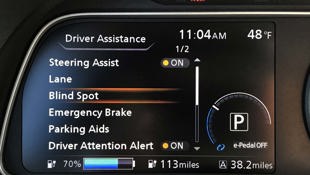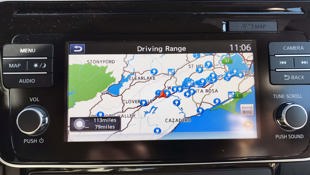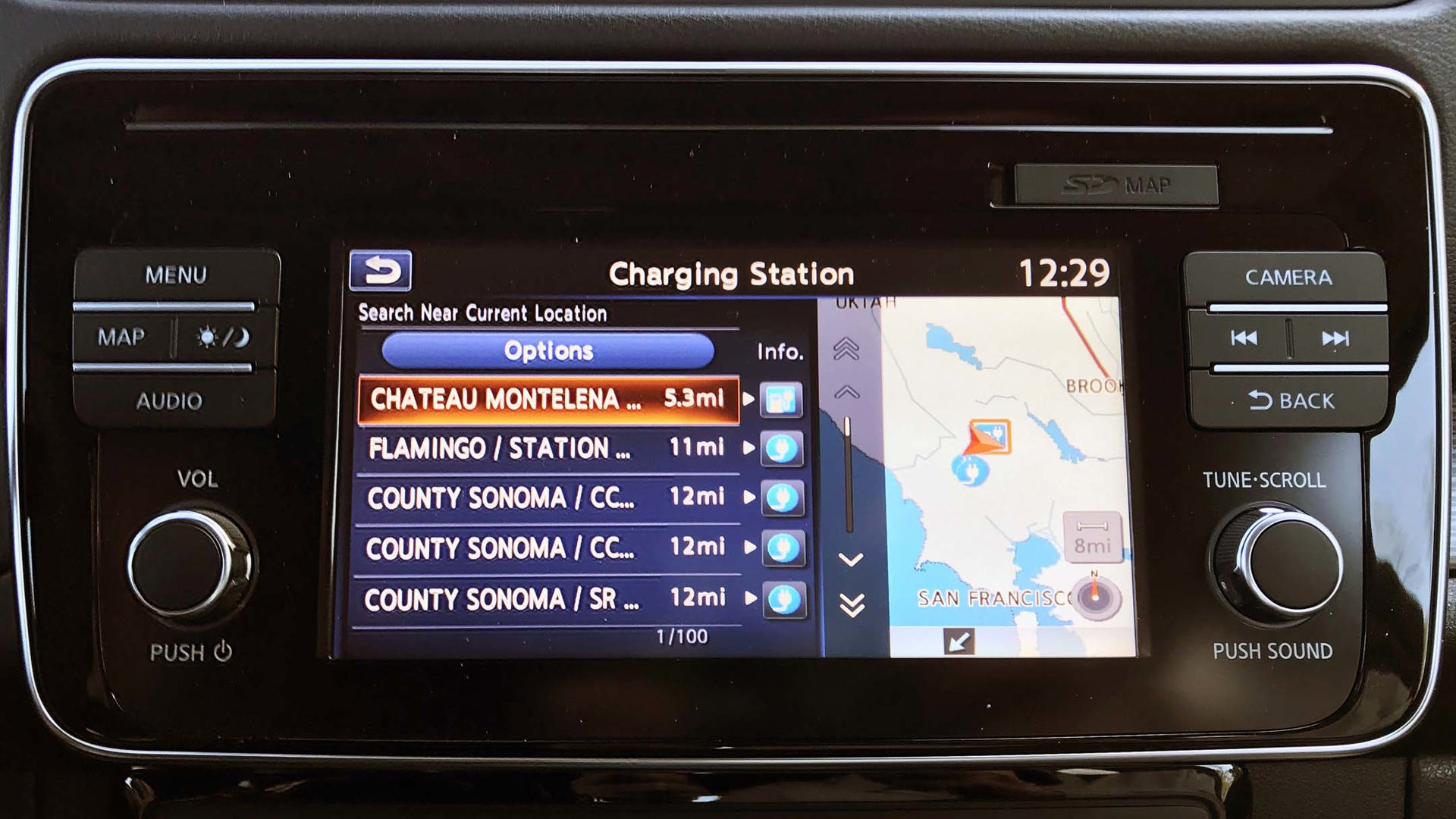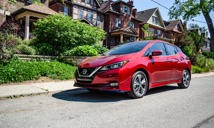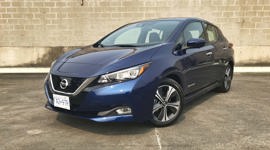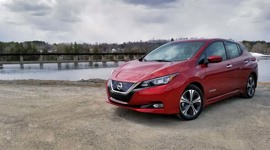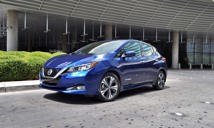After a few hours driving around the scenic (but occasionally scorched) Napa Valley in the redesigned 2018 Nissan Leaf, we came away with the feeling that even a short drive in the new Leaf would convince just about any traditional car owner that their gas-guzzling, pollution-belching internal-combustion vehicle will soon be replaced by an environmentally-friendly electric car that’s equally as quick, comfortable and easy to drive as their fossil-fuel-burning dinosaur.
In our top-of-the-line Leaf SL, we zipped through the winding valley roads of the Napa Valley with surprising speed and agility and minimal body lean.
Now with a longer driving range, more attractive (and less polarizing) styling, improved performance, and additional comfort, technology, and safety features, we think the redesigned 2018 Nissan Leaf has evolved into a more competent, comfortable, and mainstream automobile that should appeal to a larger and more diverse segment of the population.
Longest range in its class
In the under-$40,000 electric car segment, the new Leaf offers the longest (EPA-estimated) driving range (241 km), the most powerful electric motor (110 kW), and biggest lithium-ion battery (40 kW) giving it the performance credentials to outpace its major competitors, the VW e-Golf, Hyundai Ioniq Electric, Kia Soul EV, and Ford Focus Electric. Of course, you can get more power and a longer driving range if you’re willing pay approximately $10,000 more for the popular Chevy Bolt (minus provincial incentives) – but that’s a big premium to pay for an extra 140 km of range.
Nissan plans to introduce a more powerful battery in the 2019 Leaf (probably at the highest trim level), but that model will probably cross the psychologically important $40,000 threshold where the Bolt, BMW i3, and the future Tesla Model 3 reside.
Though the 2018 Leaf’s price has gone up slightly – now ranging from $35,998 to $41,998 (previously $33,998 to $40,548) the 2018 Leaf is better equipped with an all-new interior, and new technical, comfort, and safety features.
New e-Pedal offers “one-pedal” driving
Chief among these is Nissan’s new e-Pedal “one-pedal” driving mode (standard in S, SV, and SL trims) and new ProPilot Assist lane-centering system (SV and SL trims only). The e-Pedal uses a combination of regenerative braking and friction braking to slow the Leaf down when releasing the accelerator pedal, similar to moderate braking. Though other electric cars have a similar system, Nissan’s is unique in that it can stop the car and hold it in place even on steep grades up to 30 percent.
During my day’s test drive around the Napa Valley in California, I found the e-Pedal reduced the stress and strain of stop-and-go city driving. Though there is a slight increase in the effort required to depress the accelerator pedal, there is no longer a need to switch your right foot back and forth between the accelerator and brake pedal when stopping and starting. This may not seem like a big deal, but once you’ve tried the e-Pedal you realize just how tiring that can be in rush-hour traffic situations. If you need to brake quickly, you still have the option of jumping on the brake pedal – e-Pedal mode will resume automatically when you put your foot back on the accelerator pedal. Turning off the e-Pedal requires tugging on the e-Pedal button on the centre console.
e-Pedal mode is also handy when driving on winding secondary roads at speeds under 80 km/h. In a long drive up the Napa Valley, I was able to drive indefinitely without touching the brake pedal. However, once on the freeway, the extra effort required to keep the accelerator pedal down at a constant speed and the increased drag experienced when decelerating made freeway cruising less comfortable in e-Pedal mode. I simply turned off e-Pedal to drive in D or B mode.
Note that the Leaf’s brake lights will illuminate when the driver lifts their foot off the throttle in e-Pedal mode to warn following drivers that you are braking.
ProPilot Assist keeps Leaf in centre of its lane
The other new safety feature available in the 2018 Nissan Leaf (standard in SV and SL trims) is called ProPilot Assist. Activated by pressing the blue button on the steering wheel, ProPilot Assist is similar to lane-departure assist systems that gently steer a car back into its lane if it wanders near the lane markers; the difference is that ProPilot Assist uses a camera to monitor the lane markers on both sides of the Leaf and automatically keep the Leaf travelling in the centre of the lane rather than bouncing back and forth between the outside lines. In addition, using a front-mounted radar sensor, ProPilot Assist maintains a preset distance to the car in front, braking and accelerating when necessary to maintain the same speed and distance set by the driver. There are three driver-selectable distance choices.
Like cruise control, ProPilot Assist is intended to be used mostly in freeway driving where speed is constant and the lane markings are clear and unobstructed. If one of the lines disappears or is covered by dirt or snow, ProPilot Assist will disengage and reengage when the lines reappear.
If the driver uses the turn signal or attempts to steer, ProPilot Assist goes into a standby mode and reactivates when the Leaf is repositioned in the middle of the lane between lane markings. Similarly, if the driver presses the accelerator pedal, the system goes into standby mode until the driver releases the accelerator pedal. If the driver brakes, the system disengages entirely. Pressing the Resume button re-engages the previously set speed.
Owen Thunes, Manager of Nissan’s Technical Centre, took pains to point out that ProPilot Assist is not “autopilot”. “This is not a self-driving car, this is an assist function – it’s very important to keep that separate,” he emphasized. “It’s a hands-on system – it’s not driving the car for you. The driver is still engaged, but we’re reducing your workload. It makes it less stressful, less fatiguing to drive – that’s the intention of it.”
In our drive on the freeway on a clear and sunny day, I found that the Leaf stayed more or less in the centre of the lane, but when the ProPilot system disengaged because it couldn’t read the outside lines, I had to quickly take over steering control to stay on course. I found this rather uncomfortable. Personally, I would rather have complete steering control of the car or no steering control at all, rather than something in between.
As Thunes mentioned, this is not a self-driving car: if the driver is not holding the steering wheel firmly, ProPilot will activate a warning sound and a warning symbol in the instrument cluster. If the driver doesn’t respond, the warning sounds will get more frequent and the Leaf will gradually slow down and come to a complete stop in its lane with the emergency flashers on. This could be a lifesaver for a driver who’s fallen asleep or had a medical emergency.
As a test, I tried removing my hands from the steering wheel at speed in ProPilot mode. After about three seconds, the warning tone and symbol activated, but as soon as I put my hands back on the steering wheel, the warning signs disappeared. Nissan asked us not to go all the way and allow the car to stop in the middle of the freeway, but I assume the system works as advertised.
ProPilot Assist is integrated with Intelligent Cruise Control which automatically brakes and speeds up in traffic. This reduces the stress of having to continually brake and accelerate because the car does it for you. Still, you have to be ready to take over if needed.
ProPilot Assist also works in conjunction with the Leaf’s standard Automatic Emergency Braking with Pedestrian Detection to automatically brake the Leaf if a frontal collision is imminent.
More power provides improved performance
Thanks to a more powerful battery and electric motor, the 2018 Leaf now offers 147 hp, up from 107 hp in the 2017 Leaf. The 2018 Leaf feels zippier in a straight line, though not fast by any means. With three adults in our car, 0–100 km/h took just under 10 seconds. With just the driver onboard, I would guess it’s closer to 9 seconds. That’s not bad for a compact hatchback and is approximately two to three seconds quicker than the 2017 Leaf. However, it’s the new Leaf’s 0–50 km/h acceleration – the range that’s typical in city driving – that’s most useful in everyday driving. Now with 236 lb-ft of torque (up from 172 lb-ft) from the get-go, the 2018 Leaf leaps away from a standing start when floored, great for changing lanes and zipping around town.
Pressing the Eco button on the centre console reduces performance slightly but saves energy; we didn’t have a chance to determine how much energy it might save. Driving in e-Pedal mode is not only more relaxing, it’s also more energy efficient than driving in D mode because of increased energy regeneration and smoother driving. B mode also adds more energy regeneration, but less than in e-Pedal mode.
241 km driving range
With an (EPA estimated) driving range of 241 km (up from 172 km), the Leaf surpasses its major competitors, the VW e-Golf (201 km), Hyundai Ioniq Electric (200 km), Ford Focus Electric (185 km) and Kia Soul EV (179 km). Your driving range will depend on many factors, including your aggressiveness, the terrain, the outside temperature, and use of energy-draining features like air conditioning. Colder winter temperatures in particular can reduce range by up to 30 percent.
Now that it has a larger capacity battery, the 2018 Leaf requires 7.5 hours for a full charge from empty (up from 5.5 hours in the 2017 Leaf) using a typical Level 2 240 volt/30 amp charger. Using a DC fast charger, the battery can be charged to 80 percent in under 40 minutes. A standard 110V household charge now takes about 25 hours from near empty to full.
Battery is watertight
If your Leaf gets caught in a flood or you drive through a deep puddle, what will happen to your battery, and will you get electrocuted? I asked Nissan and they said their engineers in Japan tested a Leaf by driving it through a metre-deep water tunnel for 50 metres to prove that the lithium-ion battery is watertight. Nobody got zapped and the battery was unharmed. Good to know.
New Level 1/Level 2 charge cable
New for 2018 is a Level 1/Level 2 charge cable that stores in the trunk. It allows the Leaf owner to plug the car into a standard 240V outlet, just like the one for your dryer, without the need for a wall-mounted charger unit. The Level 1/Level 2 cable is standard in all 2018 Leafs.
Also new for 2018 is a redesigned front cover for the charge ports: it swings up higher so that the owner no longer has to bend down to see the charging port and risk straining their back plugging in the cable.
As before, 2018 Leaf owners can use their smartphone to set overnight charging times, heat or cool the cabin in advance, and find public charging stations using the NissanConnect EV App.
Quiet and composed ride
Out on the open road, the Leaf is quiet and composed with a comfortable ride and minimal suspension or tire noise. The absence of engine noise in an electric car can sometimes be spoiled by tire or suspension noises, but the ’18 Leaf’s cabin seems well insulated from external sounds – apart from a slight whine from the electric motor on take-off and deceleration.
Though the new Leaf uses the same (but retuned) suspension (front struts, rear torsion beam) and platform of the previous Leaf, it feels more controlled and competent when cornering at higher speeds. In our top-of-the-line Leaf SL, we zipped through the winding valley roads of the Napa Valley with surprising speed and agility and minimal body lean – assisted by grippy and quiet Michelin Green X 215/50R17 all-season radials. The Leaf’s speed-sensitive steering is comically light at parking lot speeds, but it firms up nicely at higher speeds. The Leaf’s tight 34.8 ft turning diameter makes U-turns and parking lot manoeuvres a breeze.
Classy cabin
The 2018 Leaf’s new interior features a sensible arrangement of traditional hard buttons and bright digital instruments and touchscreen controls that are easy to reach, but I suspect the absence of a hood over the centre screen will mean problems with glare. Materials quality and fit is top notch (at least in our leather-clad SL tester) and subtle blue accents in the cabin continue the exterior theme of blue trim and badge colours. A thick, flat-bottomed steering wheel provides a meaty grip.
The Leaf’s instrument cluster features a bright, easy-to-read information screen that can be toggled between different menus; a real-time power/charge gauge; battery charge level; and estimated driving range. A traditional round speedometer sits off to the right. In base Leaf S trim, the centre dash has a standard rear-view monitor while SV and SL trims include a 7-inch touchscreen for audio, climate, phone, and vehicle information including a real-time Energy Usage monitor that tells you how much power your Climate Control and other electrical systems are using as you drive.
The stubby shift lever on the console may seem fiddly to Leaf newbies – it’s definitely not a Hurst shifter. Reverse, Neutral, and Drive are engaged by toggling from right to left and then up for Reverse or down for Drive. Park is engaged by pushing the P button on top of the lever. Buttons for the e-Pedal and Eco modes are found directly in front of the shift lever while an electronic parking brake is located just behind it next to the cupholders.
With plenty of legroom and headroom, the 2018 Leaf’s interior is roomy enough for four adults but I found the high floor in the rear seating area pushed up my knees higher than I was comfortable with. Behind the rear seats, a fairly deep cargo area is accessed through the lift-up hatch. However, when the split folding rear seats are folded down, they sit up much higher than the trunk floor so it’s not a flat loading surface.
Driver visibility is generally good but there’s a bit of a blind spot in the right rear corner. Fortunately, there’s a bevy of safety nannies: blind-spot monitor, Intelligent Lane Intervention, Driver Attention Alert, and Around-View Monitor, not to mention ProPilot Assist.
2018 Nissan Leaf pricing and standard features
The base 2018 Leaf S trim (MSRP: $35,998) includes standard LED headlights, keyless entry and pushbutton start, cloth upholstery, heated front and rear seats and a heated steering wheel. But beware, once you’ve tried a heated steering wheel in the winter, you can’t go back: your next car will have to have it too.
Mid-trim Leaf SV models (MSRP: $39,598) add 17-inch alloy wheels, a navigation system, SiriusXM satellite radio, NissanConnect roadside assistance, and Apple CarPlay/Android Auto integration.
Top-of-the-line Leaf SL models (MSRP: $41,998) add leather seats, eight-way power driver’s seat with power lumbar adjuster, seven-speaker Bose sound system, a 360-degree Around-View Monitor that provides a top-down view of the area around the car, and heated side mirrors with turn signals.
Built in Smyrna, Tennessee, the 2018 Nissan Leaf is scheduled to go on sale in Canada in February or March at the 97 Nissan dealers across Canada who are authorized to service and sell the Leaf.
At the moment, government rebates for electric cars include $14,000 in Ontario, $8,000 in Quebec and $5,000 in BC. Rumour has it that the BC grant will be increased this spring.
